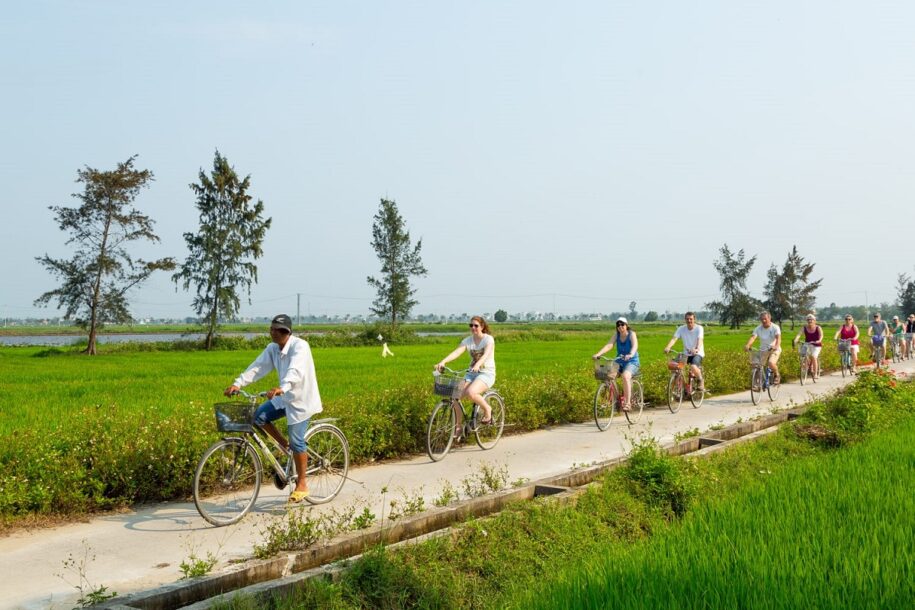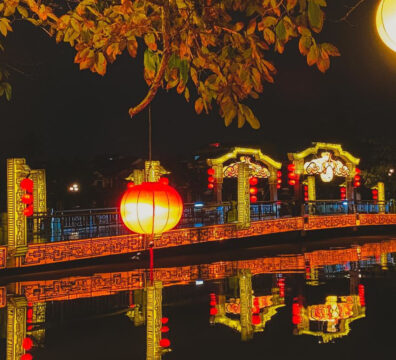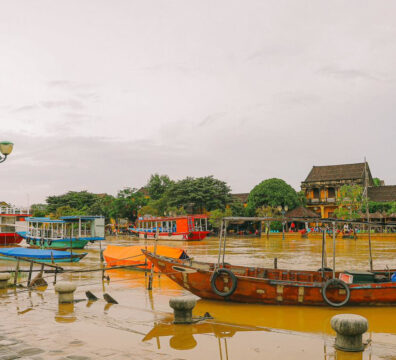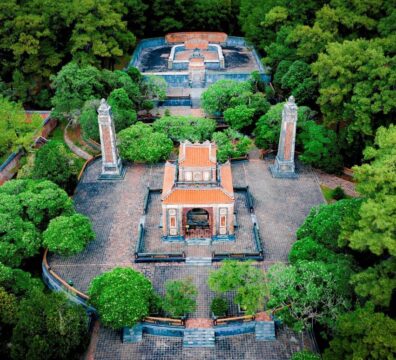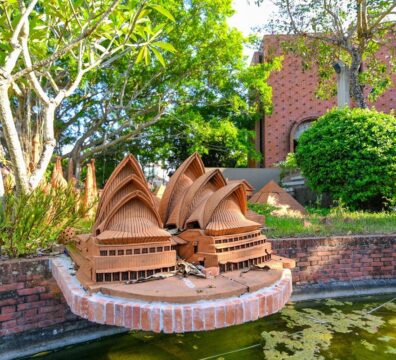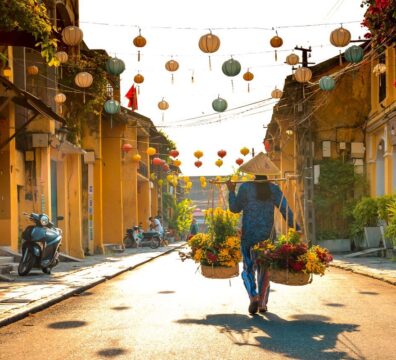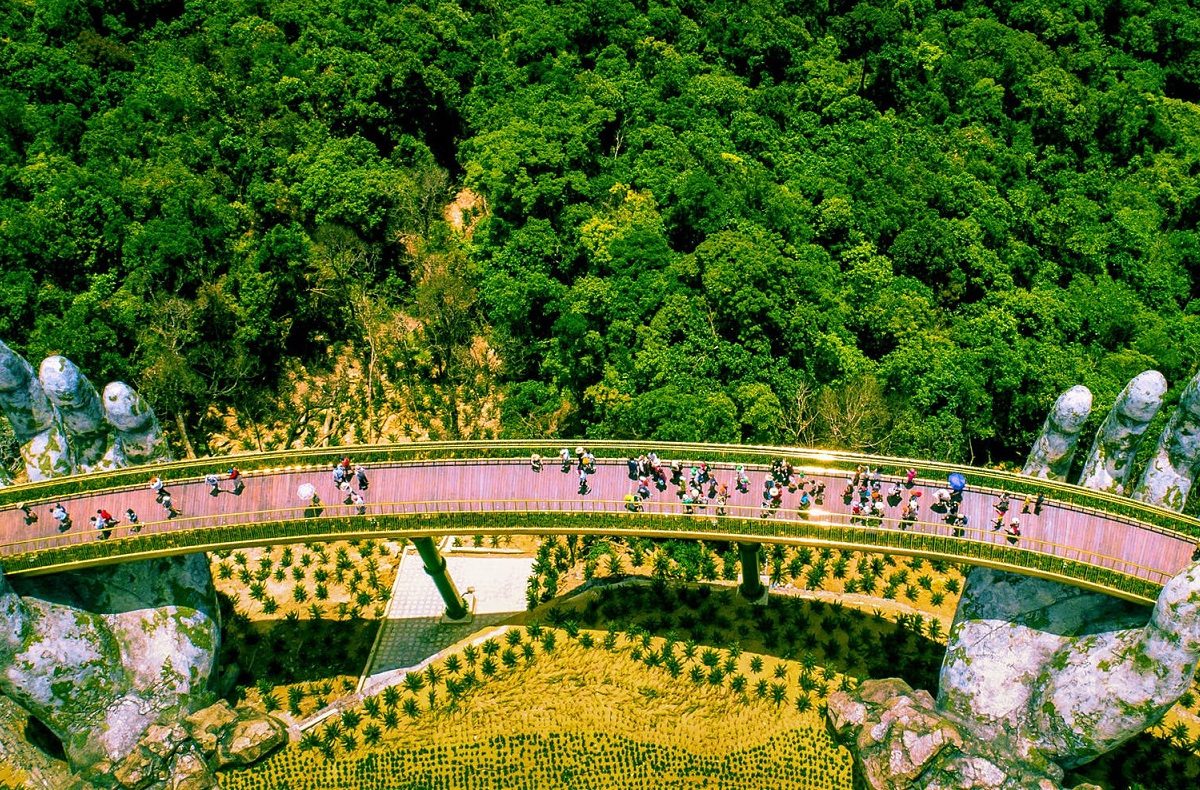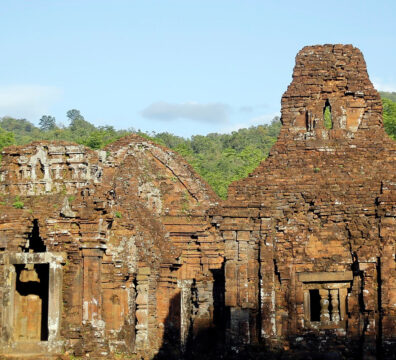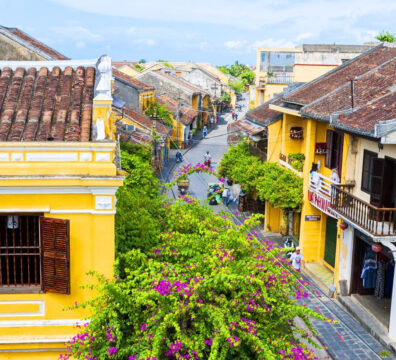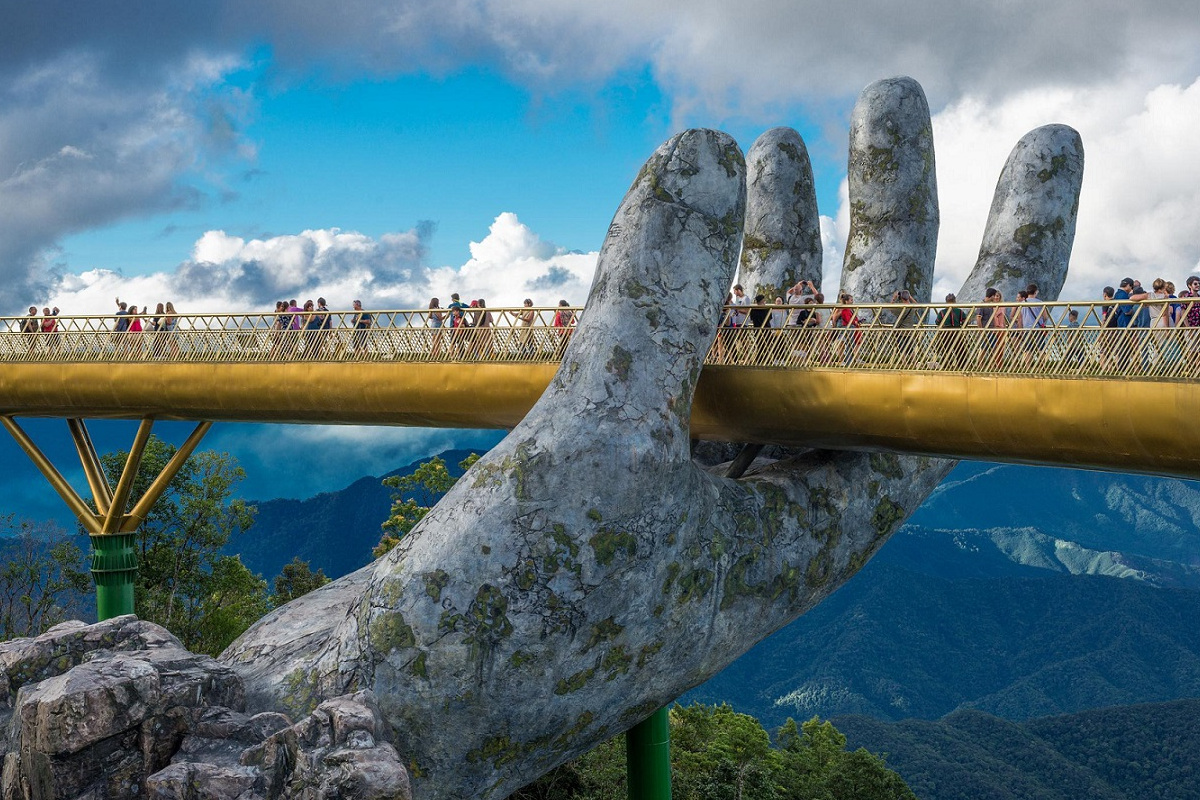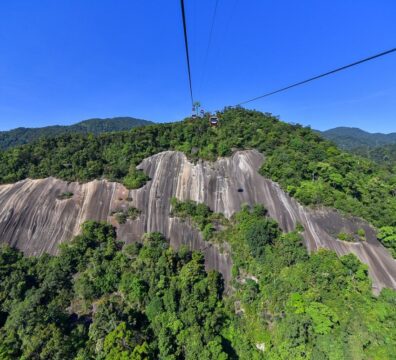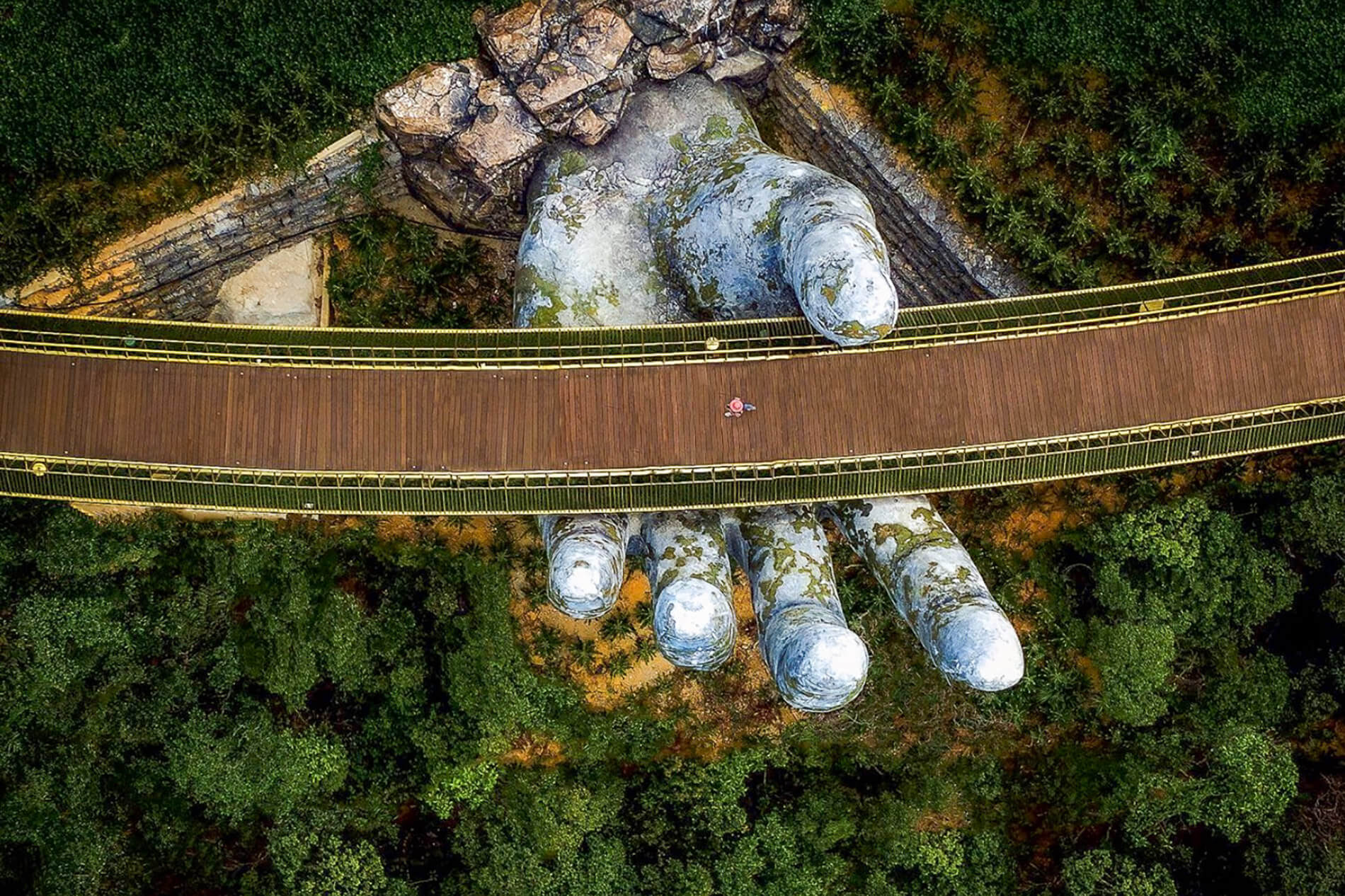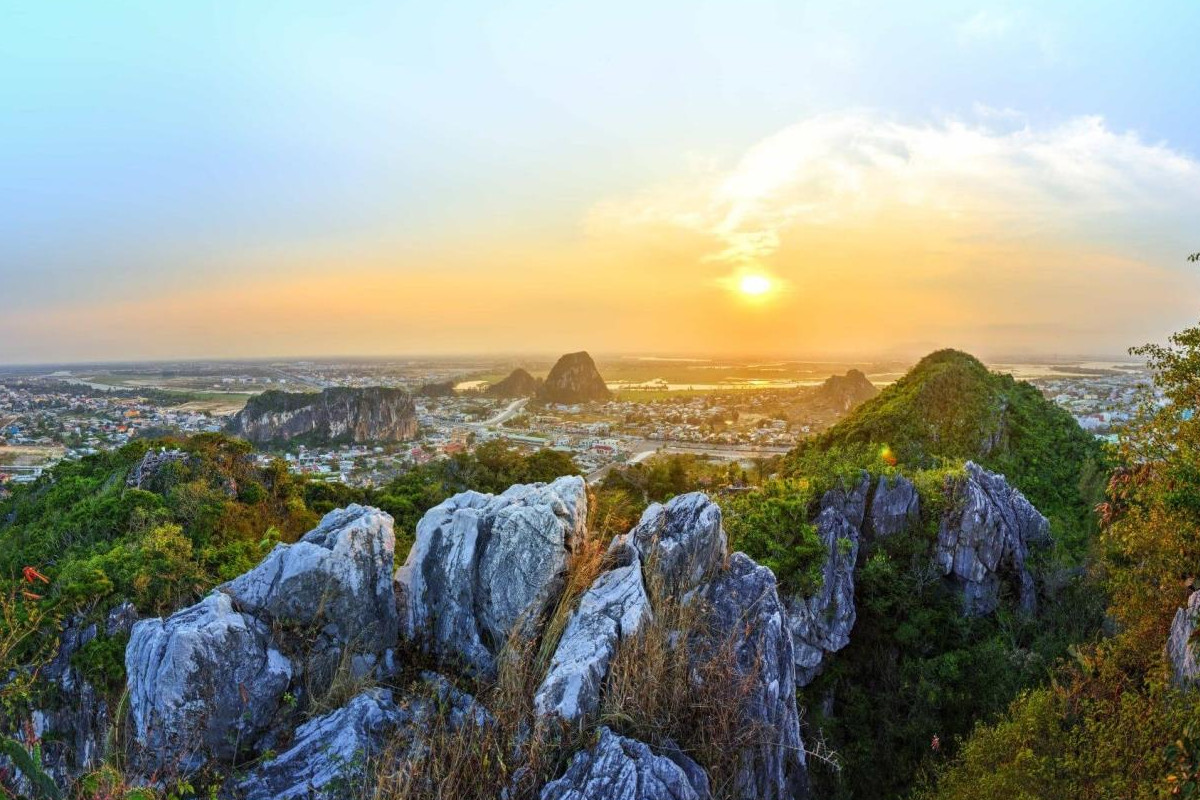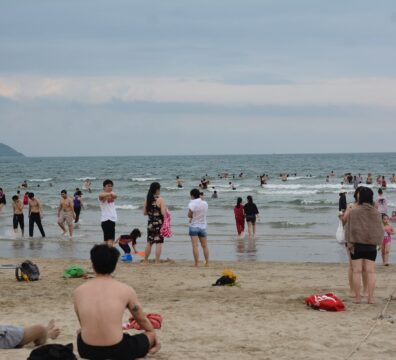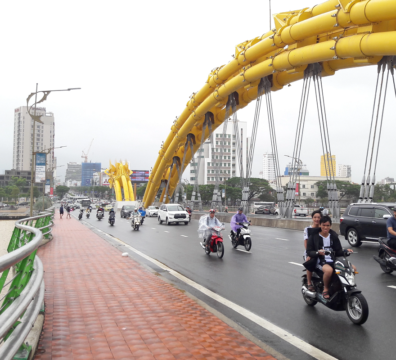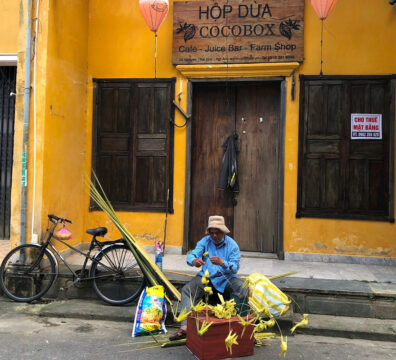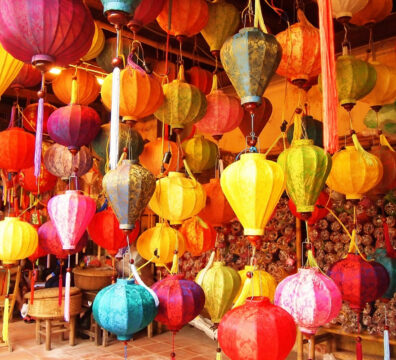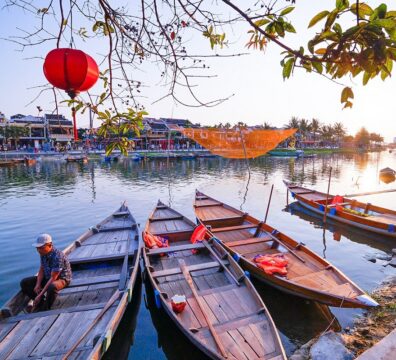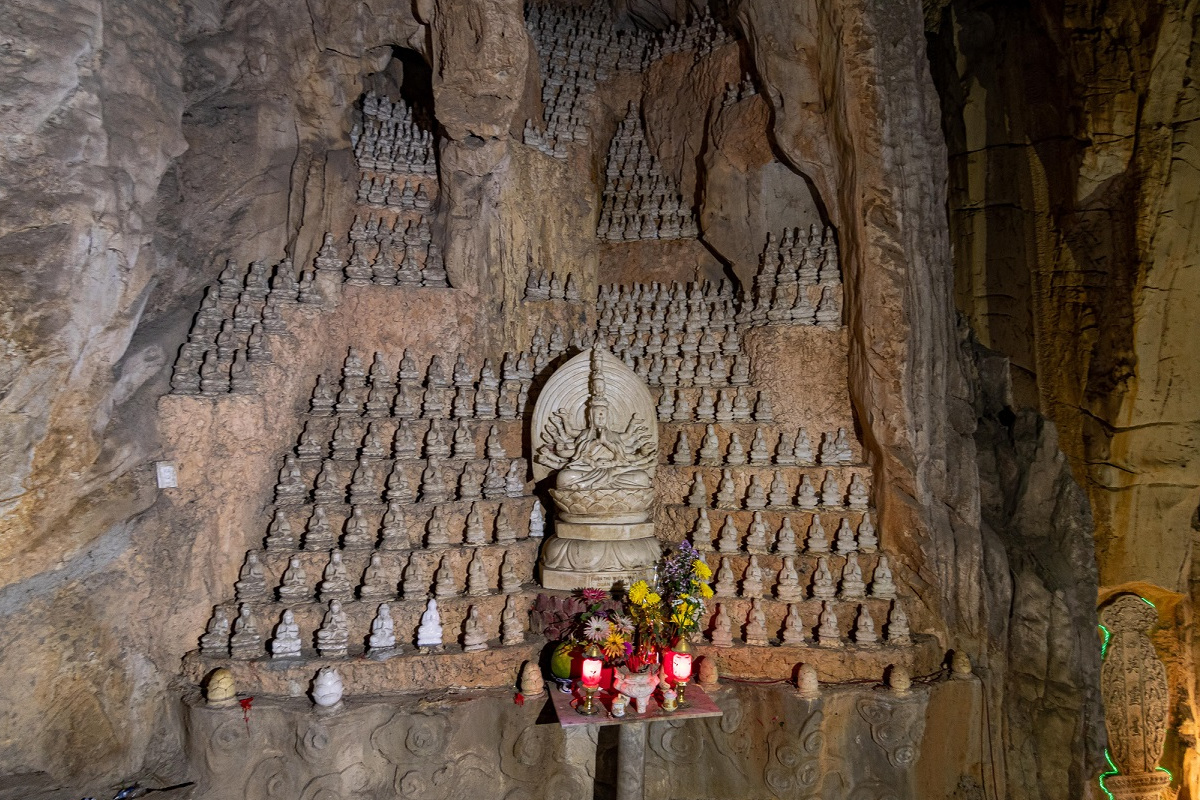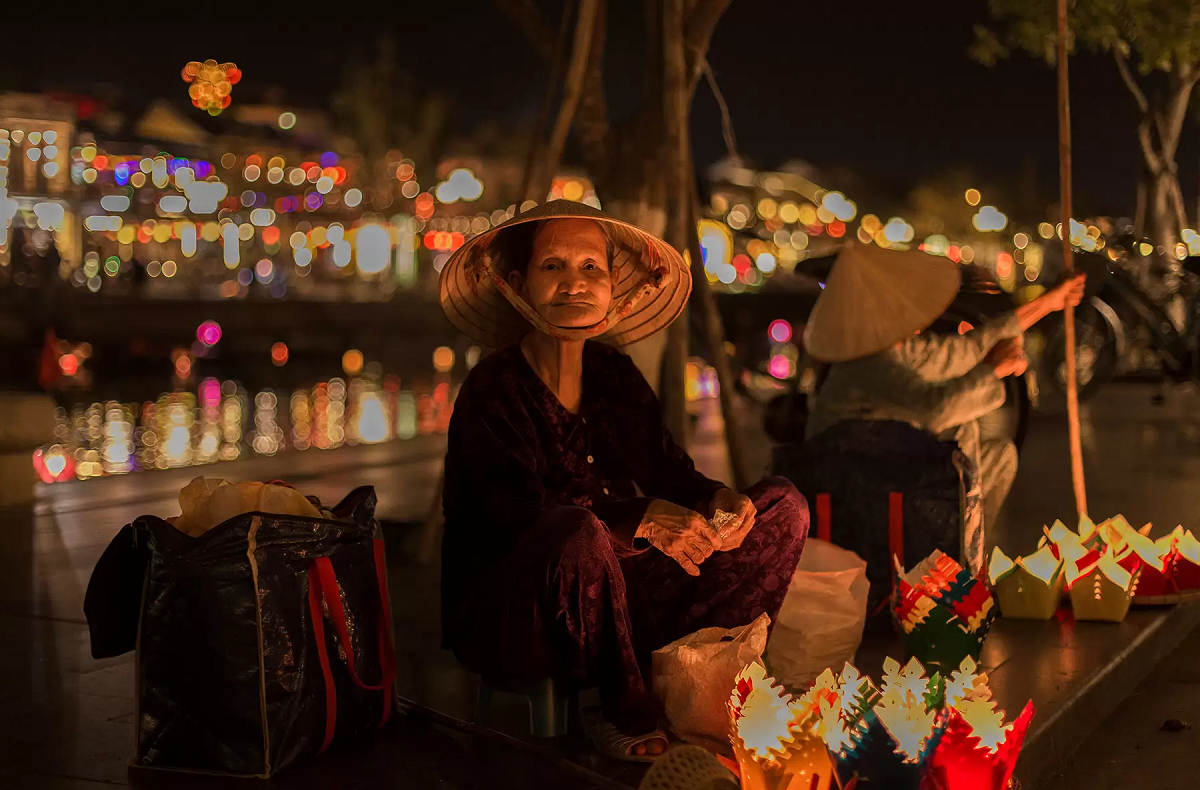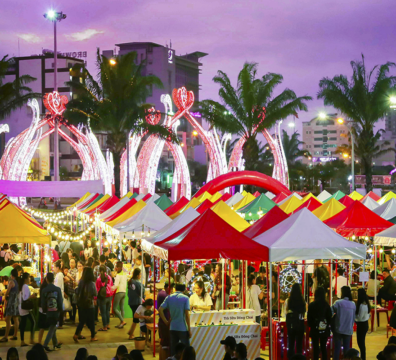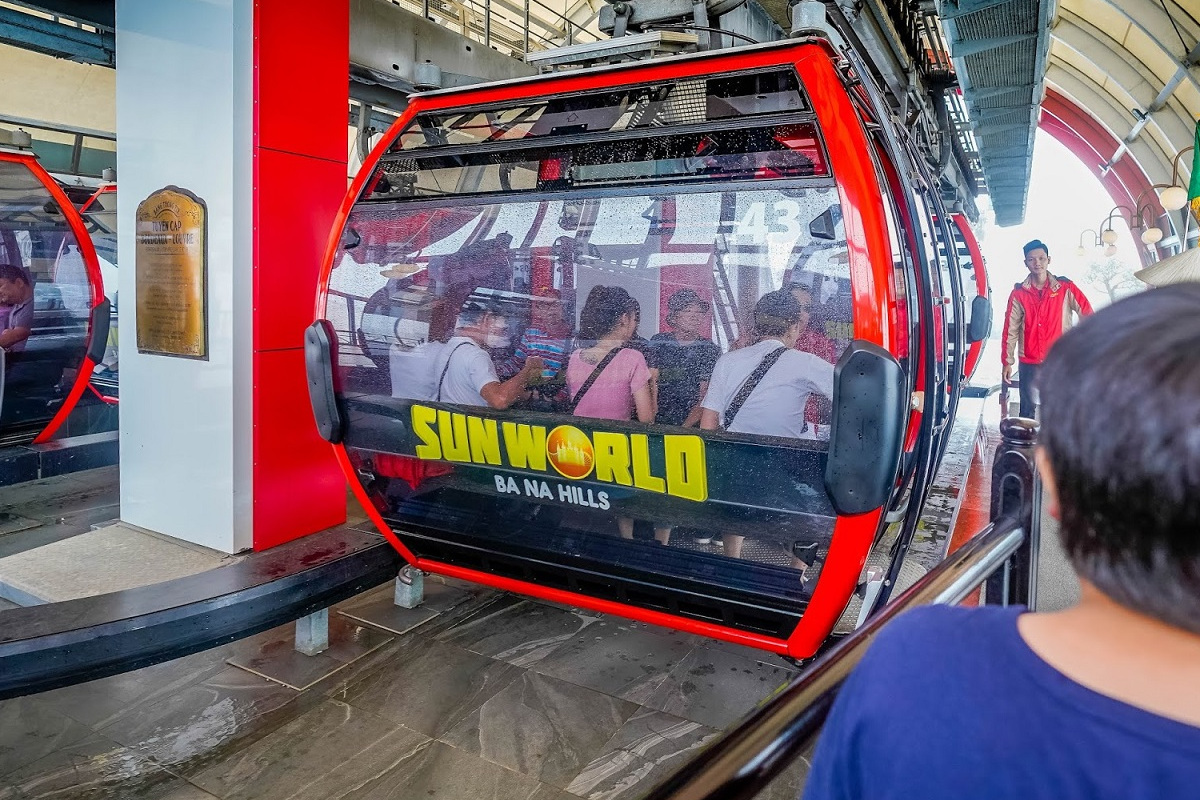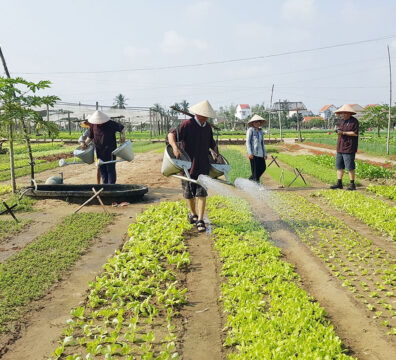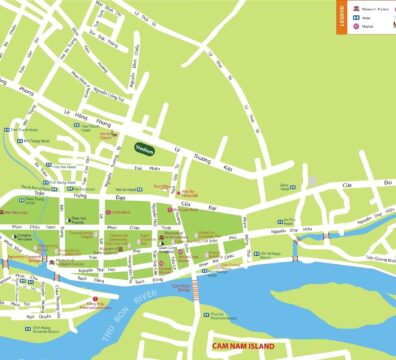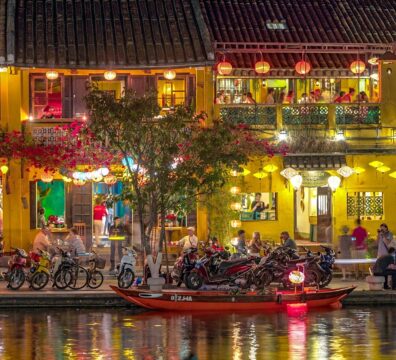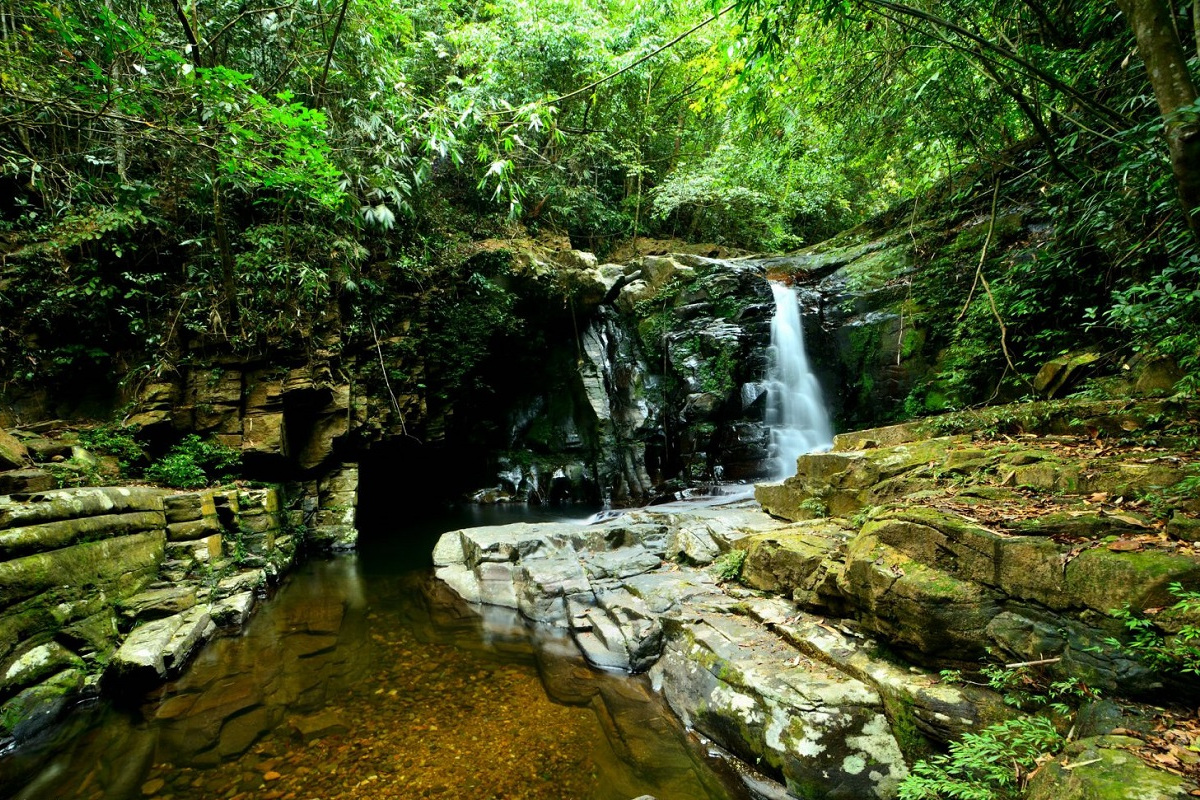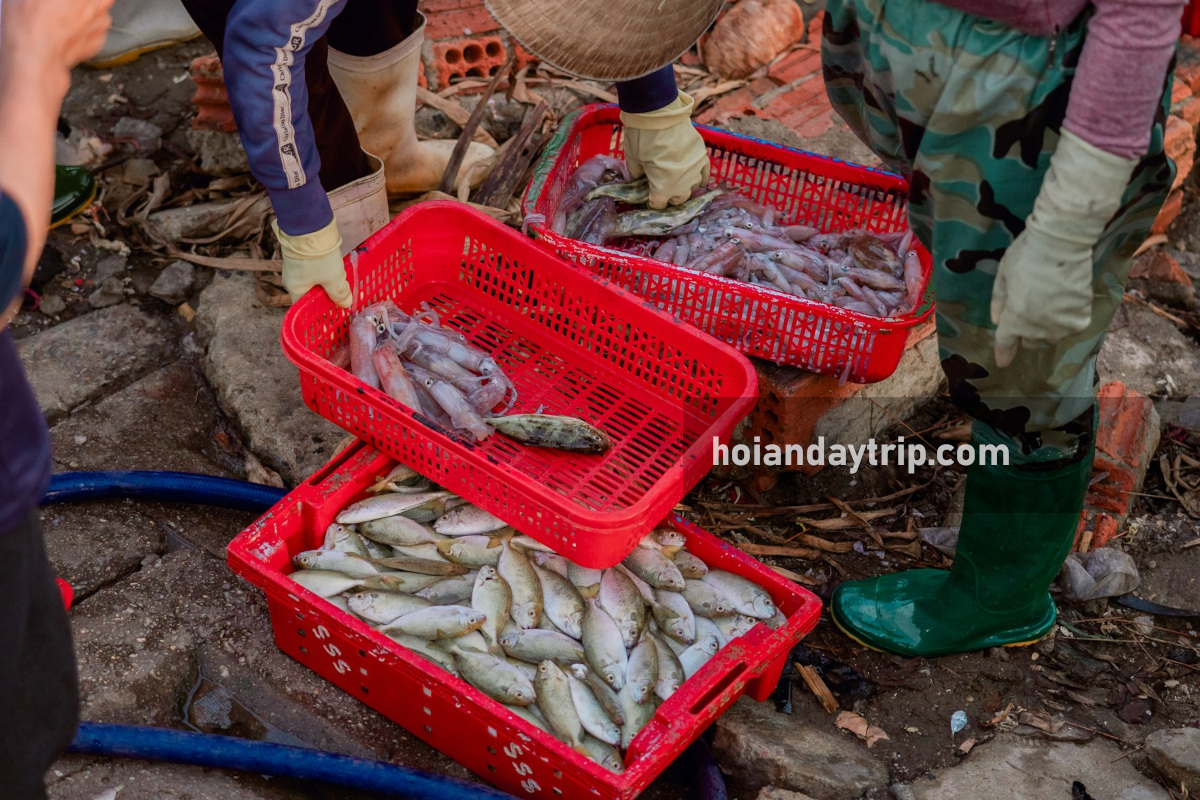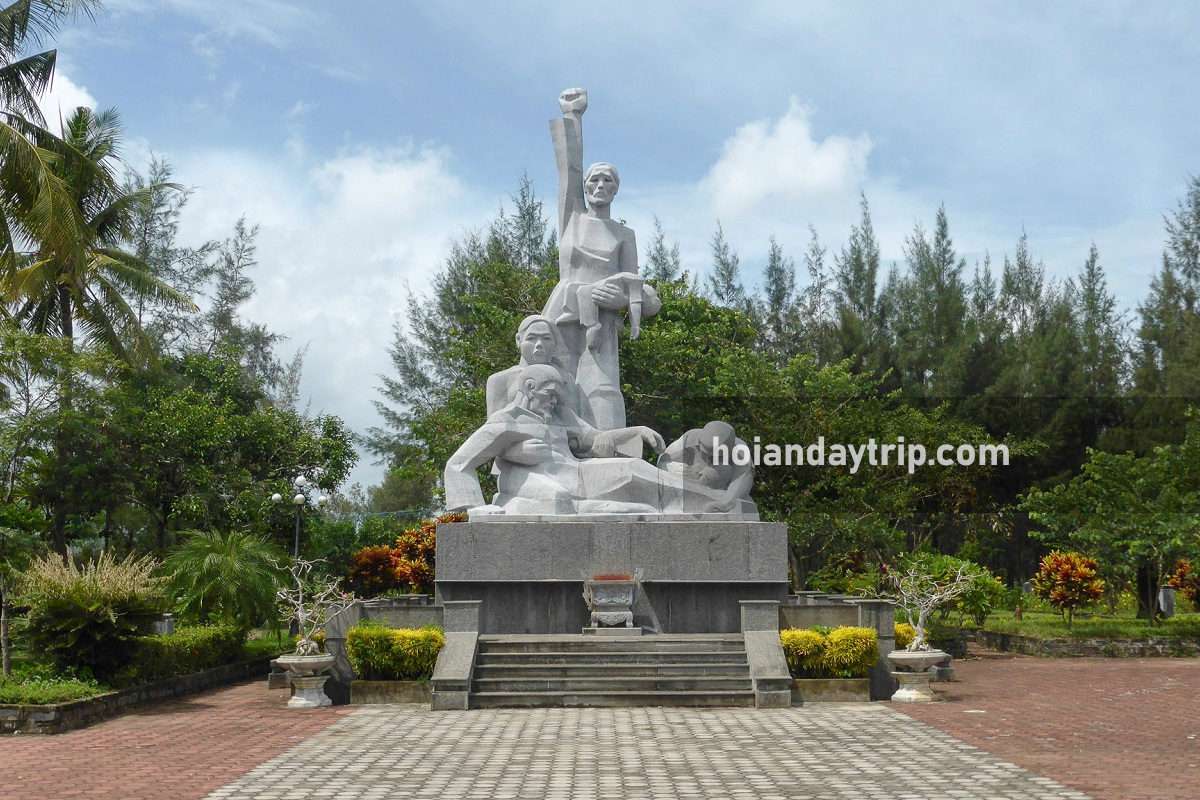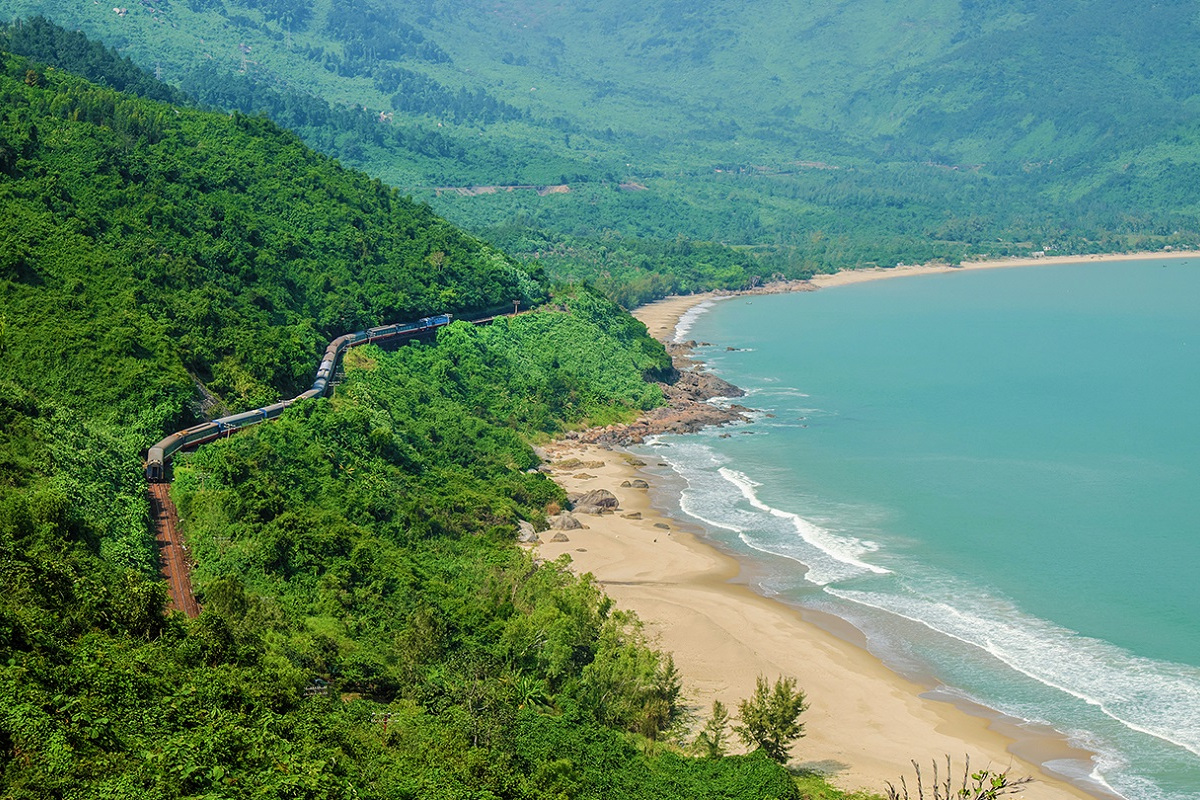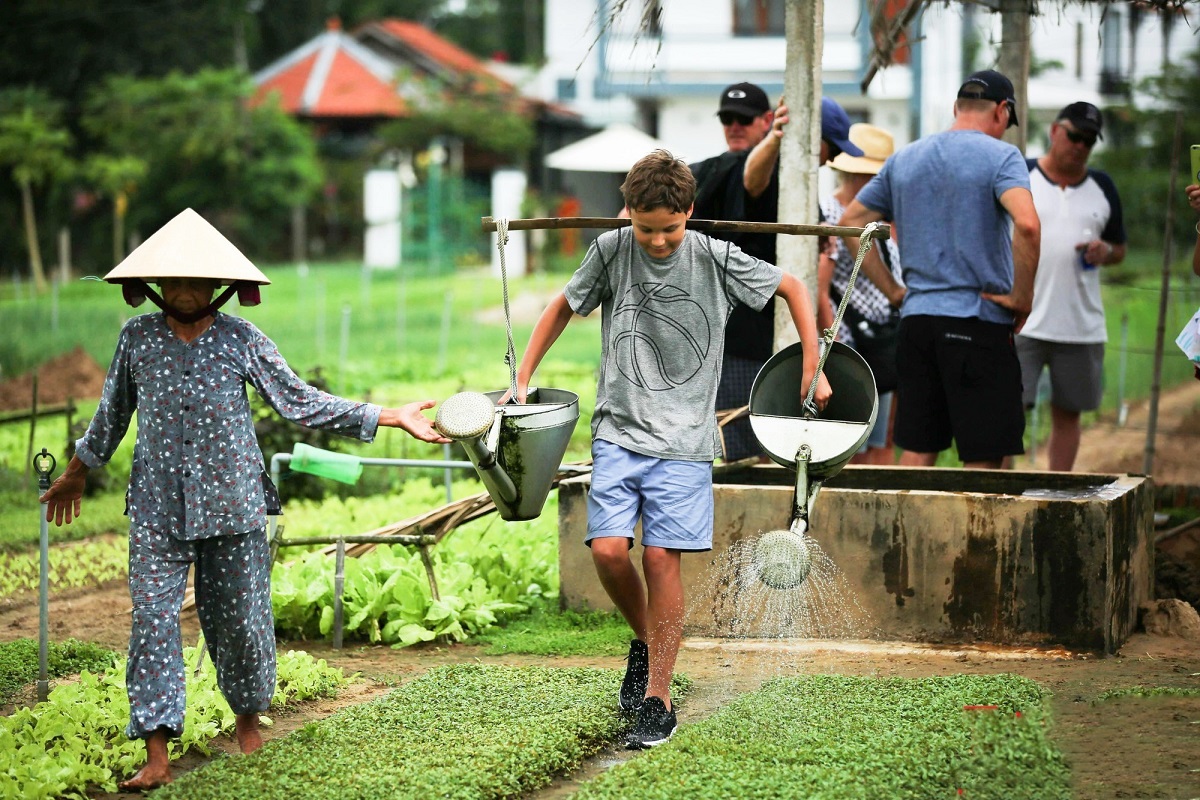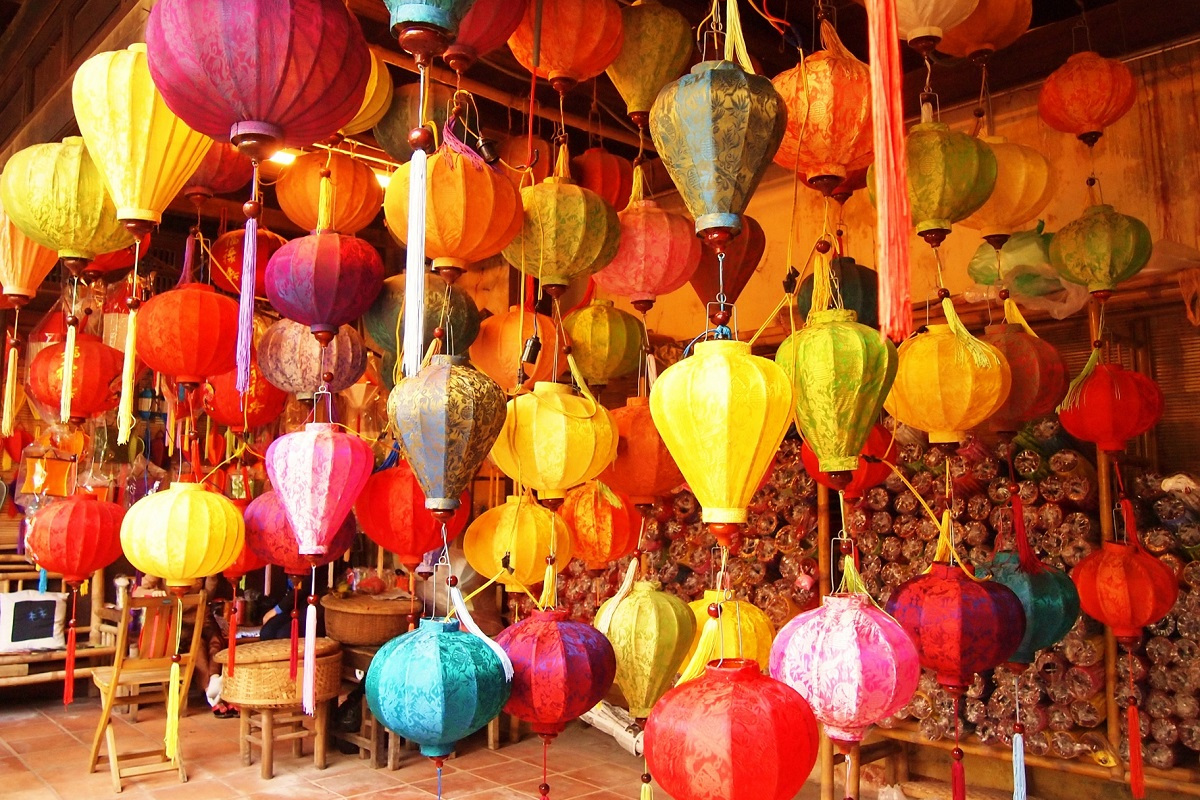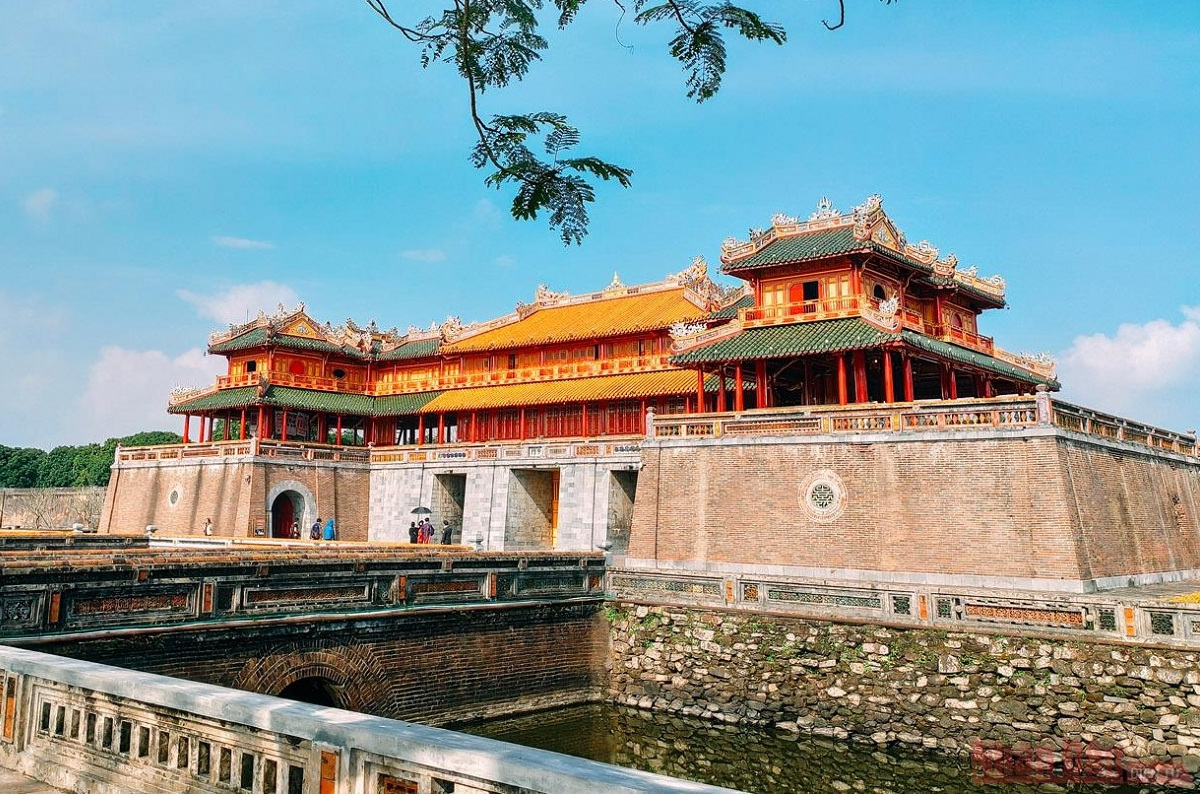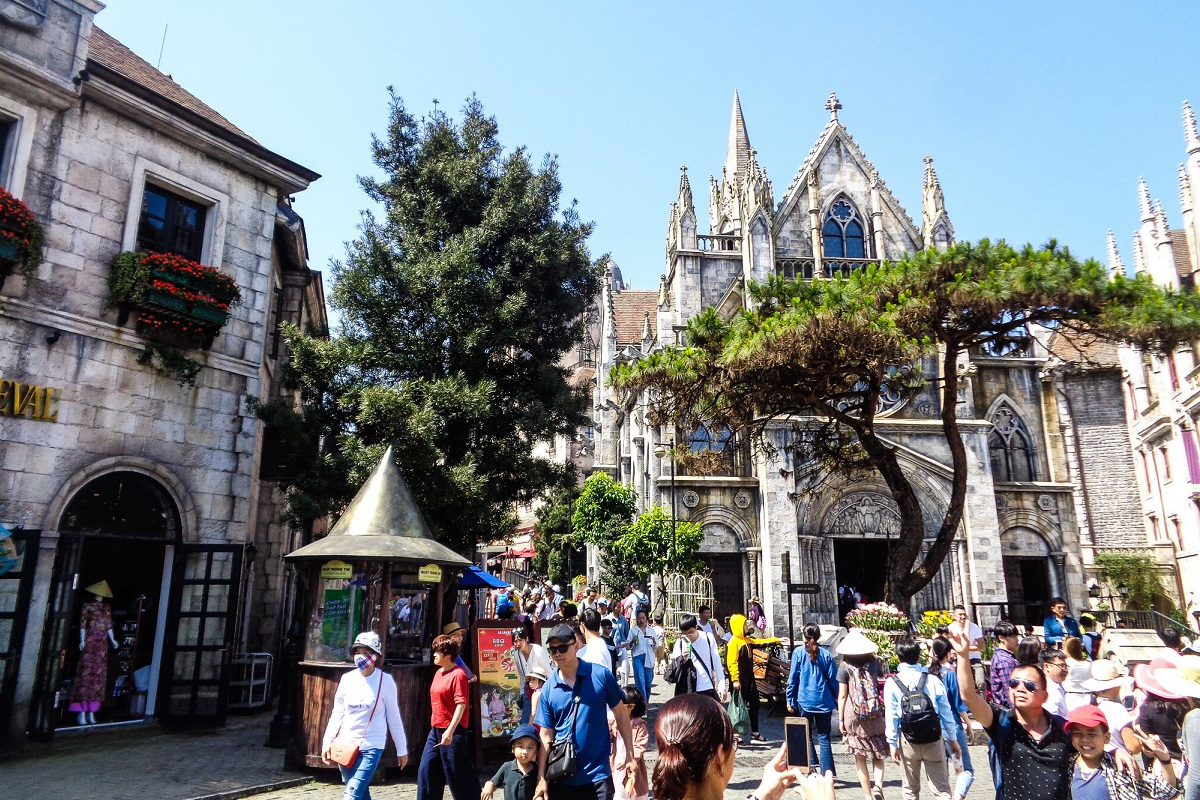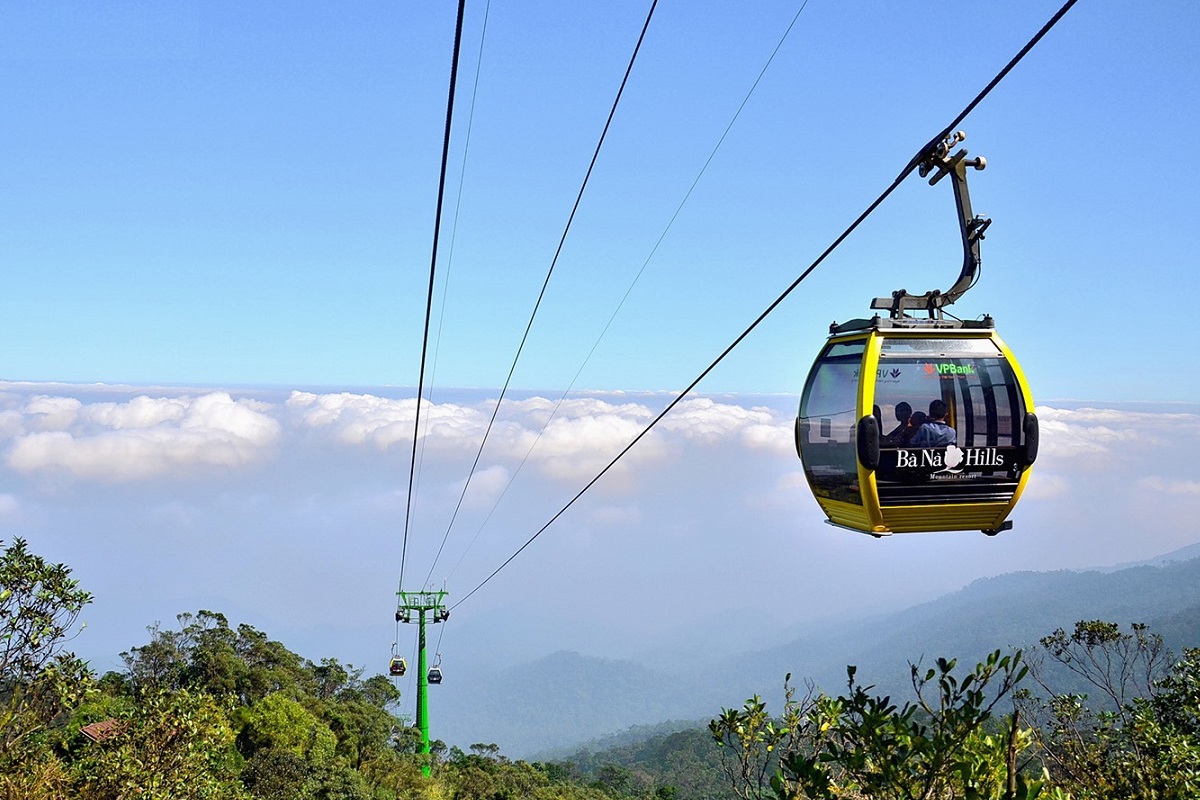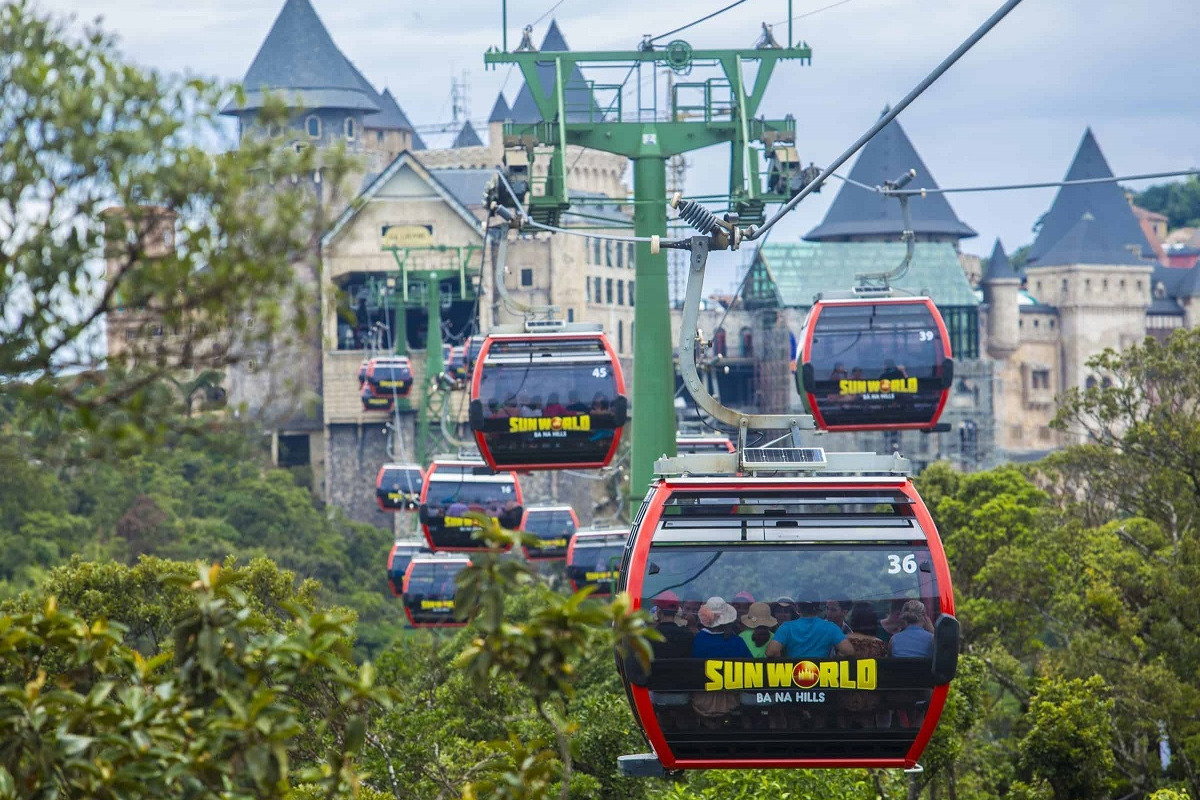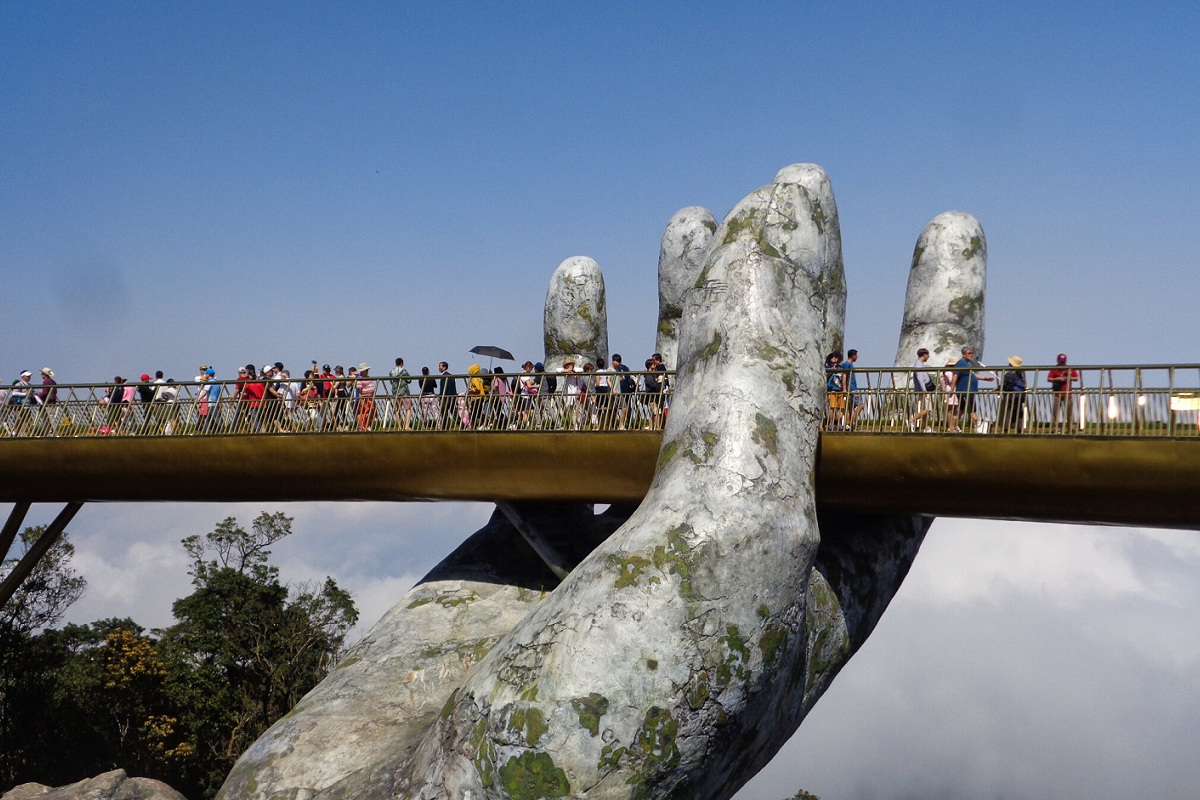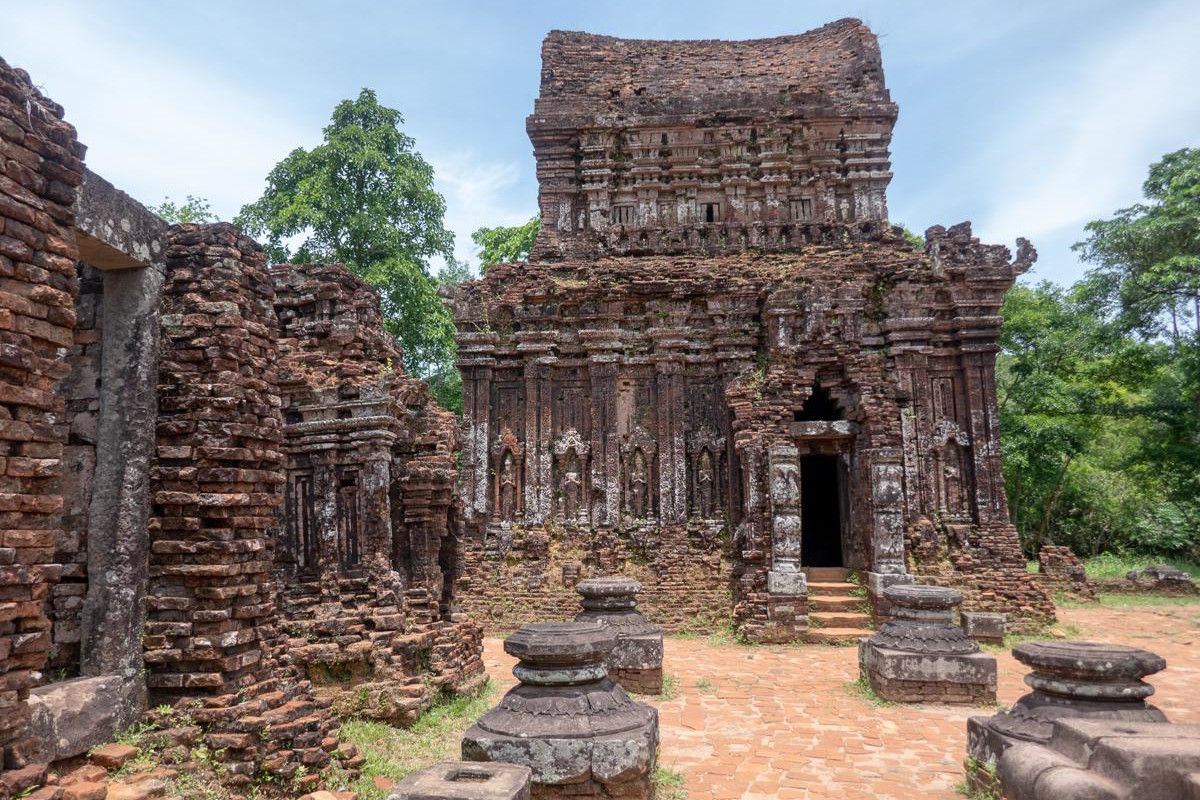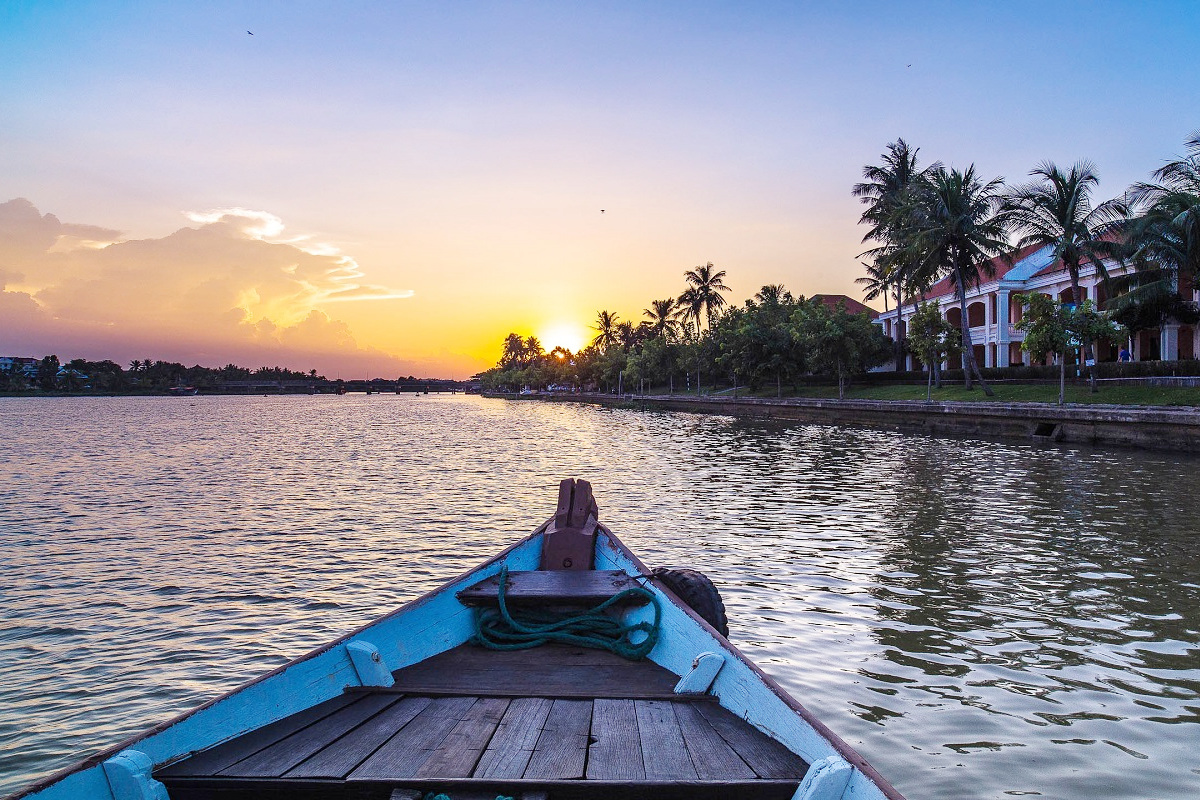By the coast, Hoi An is at the confluence of 3 rivers: Thu Bon river, Truong Giang river and De Vong river. This economically strategic location has supported trading activities in the town from first years BC to the present. From the 1400s to 1800s, Hoi An played its important role in South-east Asia, as a regional port and a center of commerce.
In addition, the delta where it sits is also fertile, occupied by Cham and then Viet populations over time. That means, its location supports agriculture and raising animals. Throughout the year, locals can grow rice, nuts, corn, vegetables, flowers, and others. Sedges are grown by many households, for making traditional sleeping matches. Nipa palm forests provide the leaf to cover house roofs and to get around them, round basket boats are used. Making full use of dense waterways and canals, fishermans set their nets and traps. Altogether, all of these features form a mosaic of differences, colors and diversity. In villages, residents are still keeping their daily ways of life, againsts increasing tourists.
Thus, Hoi An’s countryside is a great interest and deserves to be known better by travelers. For those who live in cities or another country, they have the chance to see real slices of Vietnamese rural life.
Read also:

Table of content
- 1 Tra Que Vegetable Village
- 2 Thanh Ha Pottery Village
- 3 Cam Thanh Water Coconut Village
- 4 Cam Kim Island
- 5 Kim Bong Carpentry Village
- 6 Triem Tay “Bamboo” Village
- 7 Tra Nhieu Fishing Village
- 8 Hoi An’s Rice Fields
- 9 Getting Around Hoi An’s Countryside
- 10 Countryside Tours in Hoi An
- 11 Self-Guided Cycling Tours in Hoi An
- 12 Hoi An Countryside Map
- 13 Related Posts
- 14 Non Nuoc Beach: The Famous Beach of Da Nang
- 15 How to Get from Da Nang to My Son Sanctuary
- 16 Thieu Tri Tomb: The Peaceful Royal Tomb of Hue
- 17 Bach Ma National Park: Hiking, Trekking in Da Nang and Hoi An
- 18 Hoi An Wet Season: What to Do in Hoi An When It Rains?
- 19 Hue to Da Nang By Train: The Best Train Ride in Vietnam
- 20 Hue Royal Tombs: A Complete Guide and What is Best?
- 21 The Hue Abandoned Water Park (Thuy Tien Lake Waterpark)
- 22 Minh Mang Tomb Complete Visitor Guide
- 23 Tu Duc Tomb Complete Visitor Guide
- 24 Thanh Ha Terracotta Park
- 25 Vinwonders Nam Hoi An Theme Park (formerly Vinpearl Nam Hoi An)
- 26 Am Phu Cave (Hell Cave) – Things to Do in Da Nang
- 27 Hoi An or Hue: Which is Better?
- 28 Asia Park and Sun Wheel in Da Nang (Sun World Da Nang Wonders)
- 29 The Official Hoi An Travel Guide (MUST READ)
- 30 The Hoi An Market (Hoi An Central Market) Complete Guide
- 31 Hoi An Memories Show: The Best of Hoi An Impression Theme Park
- 32 How to Get to Golden Bridge from Da Nang
- 33 Hoi An Bridge: Famous Bridges in Hoi An
- 34 Da Nang Food Specialties: What to Eat in Da Nang
- 35 How to Get From Hoi An to My Son Sanctuary
- 36 Hoi An’s Chinese Assembly Halls and Chinese Temples
- 37 Hoi An Walking Tours: Heritage, Foods, Photography & Locals
- 38 Hoi An Self Guided Walking Tour – Hoi An On Your Own
- 39 How to Visit Golden Bridge Vietnam
- 40 Da Nang Shore Excursions: Guided Tours From Tien Sa Port
- 41 Unique Experiences in Hoi An and Why?
- 42 Han Market (Cho Han): Where to Shop in Da Nang?
- 43 An Bang Beach: A Guide to Hoi An’s Best Beach
- 44 Experiences in Hoi An: Get Insight Into Hoi An’s Local Culture
- 45 Da Nang Cathedral (Da Nang Pink Church)
- 46 Things to Do in Ba Na Hills Besides Golden Bridge
- 47 Hoi An Nightlife: What to Do in Hoi An At Night?
- 48 Hoi An Countryside: Villages, Rice Fields & Tours
- 49 How to Get to Golden Bridge From Hoi An
- 50 Hoi An Entrance Fee: Old Town, Golden Bridge, My Son, More
- 51 Hoi An Airport: Everything You Need to Know
- 52 Hoi An Lantern Boat Ride on Hoai River
- 53 Da Nang Half Day Tours
- 54 Hoi An Private Car and Driver
- 55 Da Nang Private Car and Driver
- 56 What to Do in Hoi An Ancient Town
- 57 Da Nang and Hoi An Itinerary for Visitors Staying Overnight in Hoi An
- 58 Hoi An 3 Day Itinerary: A Travel Plan for 3 Days in Hoi An
- 59 Hoi An Free Things to Do: Budget Travel in Hoi An Vietnam
- 60 Hoi An One Day Itinerary: A Travel Plan for One Day in Hoi An
- 61 Da Nang Things to Do: Guide to What to Do in Da Nang Vietnam
- 62 Da Nang Best Things to Do and Reasons
- 63 Hoi An Half-Day Tours: Guide to Half Day Trips From Hoi An
- 64 Hoi An Day Tours: A Guide to Best Day Trips From Hoi An
- 65 Hoi An Beach: A Guide to All Beaches in Hoi An Vietnam
- 66 Hoi An Food Specialties
- 67 How to Get From Hoi An to Da Nang
- 68 Hoi An Cheap Things to Do: All Solo Travelers Need to Know
- 69 Hoi An Best Things To Do: Recommendations from Local Experts
- 70 Hoi An Things to Do: All What Can You Do in Hoi An Vietnam
- 71 Hoi An Things Not to Miss: A Guide to Must Do in Hoi An
- 72 Hoi An or Da Nang: Which is Better for First Time Visitor?
- 73 Hoi An Pottery Village: A Guide to Thanh Ha Pottery Village
- 74 Hoi An Ancient Town Tour
- 75 Hoi An Old Town Ticket: Price, Sellers, Included Sites, More
- 76 My Son Sanctuary Tour
- 77 Hoi An Lanterns: Festival, Making Class, Where to Buy, More
- 78 Hoi An Best Area to Stay: Guide to Where to Stay in Hoi An
- 79 Hoi An Weather by Month: Guide to Hoi An Monthly Weather
- 80 Da Nang Best Area to Stay: Guide to Where to Stay in Da Nang
- 81 Da Nang Cave Tour: Best Underground Activities in Da Nang
- 82 Da Nang Best Time to Visit: Guide to Best Weather in Da Nang
- 83 Da Nang Weather by Month: Guide to Monthly Weather in Da Nang
- 84 What to Do in Da Nang At Night
- 85 Lang Co Vietnam Travel Guide
- 86 Hoi An River Cruise: Guide to The Best Boat Tour in Hoi An
- 87 What to Do in Da Nang for 3 Days
- 88 Hoi An Old Town Boats: Guide to Boat Rides in Hoi An Town
- 89 Hoi An 2 Day Itinerary: Traveler Guide to 2 Days in Hoi An
- 90 Cham Island Hoi An
- 91 Hoi An Basket Boat Ride
- 92 Hoi An Coconut Village: A Guide to Cam Thanh Coconut Village
- 93 My Khe Beach: A Complete Guide to Da Nang’s Best Beach
- 94 Thien Mu Pagoda: Guide to Hue’s Most Famous Buddhist Temple
- 95 Perfume River Cruise: Guide to Best Boat Tour in Hue Vietnam
- 96 Tomb of Khai Dinh: The Most Unique Royal Tomb of Hue
- 97 Da Nang Day Trips: Guide to Best Day Tours From Da Nang
- 98 Museums in Da Nang
- 99 Linh Ung Pagoda: Trio of Da Nang’s Holiest Mountain Temples
- 100 Da Nang Night Market: A Thing To Do in Da Nang at Night
- 101 Guide to Son Tra Mountain (Monkey Mountain) in Da Nang, Vietnam
- 102 Ba Na Hills Tour
- 103 Hoi An Cham Temples: My Son Sanctuary & Quang Nam Temples
- 104 Da Nang Cable Car
- 105 How to Get from Da Nang Airport to Hoi An
- 106 Da Nang to Hoi An: Best Da Nang Airport Transfer and More
- 107 Hoi An Tour Guide: How to Find a Private Tour Guide in Hoi An
- 108 Hoi An Ancient Town Attractions
- 109 Hai Van Pass Da Nang: Map, Route, Weather, History, Tour
- 110 Hoi An Old Town Map
- 111 Tra Que Vegetable Village
- 112 Guide to Hoi An Lantern Festival – Hoi An Full Moon Festival
- 113 Hue Imperial City and Forbidden City
- 114 Featured Tours and Experiences
- 114.0.1 Bach Ma National Park Tour from Hue
- 114.0.2 Bach Ma National Park Tour from Da Nang/Hoi An
- 114.0.3 Hoi An Sunrise Fish Market Tour
- 114.0.4 My Lai Massacre Tour
- 114.0.5 Golden Bridge/Ba Na Hills & Hoi An Tour
- 114.0.6 Hoi An Instagram Tour
- 114.0.7 Ky Anh Tunnel & Tam Thanh Mural Village Tour
- 114.0.8 Da Nang to Hue Motorbike Tour with Hai Van Pass & Easy Rider (1 Way)
- 114.0.9 Hue to Da Nang Motorbike Tour with Hai Van Pass & Easy Ride (1 Way)
- 114.0.10 Hue to Hoi An Motorbike Tour with Hai Van Pass & Easy Rider (1 Way)
- 114.0.11 Hoi An to Hue Motorbike Tour with Hai Van Pass & Easy Rider (1 Way)
- 114.0.12 Tra Que Vegetable Village Tour with Cooking Class
- 114.0.13 Ba Na Hills Half Day Tour from Hoi An
- 114.0.14 Marble Mountain & Hoi An Day Tour from Da Nang Port
- 114.0.15 Hue Day Tour from Chan May Port with Lunch
- 114.0.16 Marble Mountain & Hoi An Tour from Chan May Port
- 114.0.17 Ba Na Hills/Golden Bridge Tour from Da Nang Port
- 114.0.18 Ba Na Hills/Golden Bridge Tour from Chan May Port
- 114.0.19 Golden Bridge Private Tour with Ba Na Hills & Lunch
- 114.0.20 Ba Na Hills Afternoon Tour with Golden Hands Bridge
- 114.0.21 Ba Na Hills Private Tour with Golden Hands Bridge
- 114.0.22 Ba Na Hills Half Day Tour with Golden Bridge
- 114.0.23 Ba Na Hills Early Morning Tour to Beat the Crowds
- 114.0.24 Golden Bridge and Ba Na Hills Night Tour
- 114.0.25 Golden Hands Bridge Tour In Sunrise or Sunset (1/2 Day)
- 114.0.26 Cam Kim Island Bicycle Tour From Hoi An
- 114.0.27 Cham Island Tour From Hoi An (Group Tour)
- 114.0.28 Cham Island Tour From Da Nang (Group Tour)
- 114.0.29 Hoi An Vegetarian Food Tour
- 114.0.30 Hoi An Evening Walking Food Tour with Local Foodie
- 114.0.31 Private Hoi An Basket Boat Tour (Shuttle Bus, Bicycle, Bike)
- 114.0.32 Half-day Am Phu Cave Tour (Private)
- 114.0.33 Hoi An Countryside Tour by Electric Car or Bike
- 114.0.34 Da Nang Tour Package From Singapore
- 114.0.35 Hoi An Evening Tour From Da Nang with Lantern Boat Ride
- 114.0.36 Hoi An Walking Food Tour Through Laneways
- 114.0.37 My Son Sanctuary and Hoi An Old Town Tour
- 114.0.38 My Son Day Trip From Hoi An including Marble Mountains and Basket Boat
- 114.0.39 Half Day Hoi An City Tour With River Cruise
- 114.0.40 Son Tra Peninsula Tour with Marble Mountains (Private/Small Group)
Tra Que Vegetable Village
2 kilometers north of Hoi An ancient town, on the way to An Bang beach, Tra Que vegetable village is a well-known rural village. Here, Vietnamese farmers have grown vegetables and herbs since 16th century. They still use traditional techniques in the gardens daily that are organic, friendly to the environment. One of them is the use of seaweed to fertilize. Thanks to the village’s location – an island on the river, the soil is rich in nutrients. Locals believe that veggies from Tra Que village are of the best qualities. The ones are also tiny. Many Hoi An’s food specialties require them, including Cao lau – the signature dish of the town, Mi quang noodle, banh mi sandwich, banh xeo pancakes, etc. Read further information in Tra Que vegetable village visitor guide.
Things to do in Tra Que vegetable village:
– See lush, green gardens with a variety of vegetables and photograph farmers at work
– Be a farmer and learn how to grow vegetables
– Learn to make some classic Vietnamese dishes, including the specialty of the village – Tam huu (a roll of boiled pork, boiled shrimp and herbs)
– Have a foot massage
– Have lunch prepared by vegetables hand-picked from nearby gardens and enjoy a peacefulness at thatched restaurants
How to get there: By Hai Ba Trung road, from the town to the beach, Tra Que village is accessible by all road vehicles. Riding a bicycle allows visitors to tour rice fields and other rural areas, after a visit around the village.
History: Vietnamese people have settled down in the village since 17th century. Name of the village was made by the king who loved the taste of local herbs.
Special events: Cau Bong festival takes place on the 7th day of the first lunar month in which every family makes Tam huu rolls to compete.
Read also: My Son Sanctuary Travel Guide
Book tours to Tra Que Vegetable Village in Hoi An
Contact us by +84968009827 (WhatsApp)
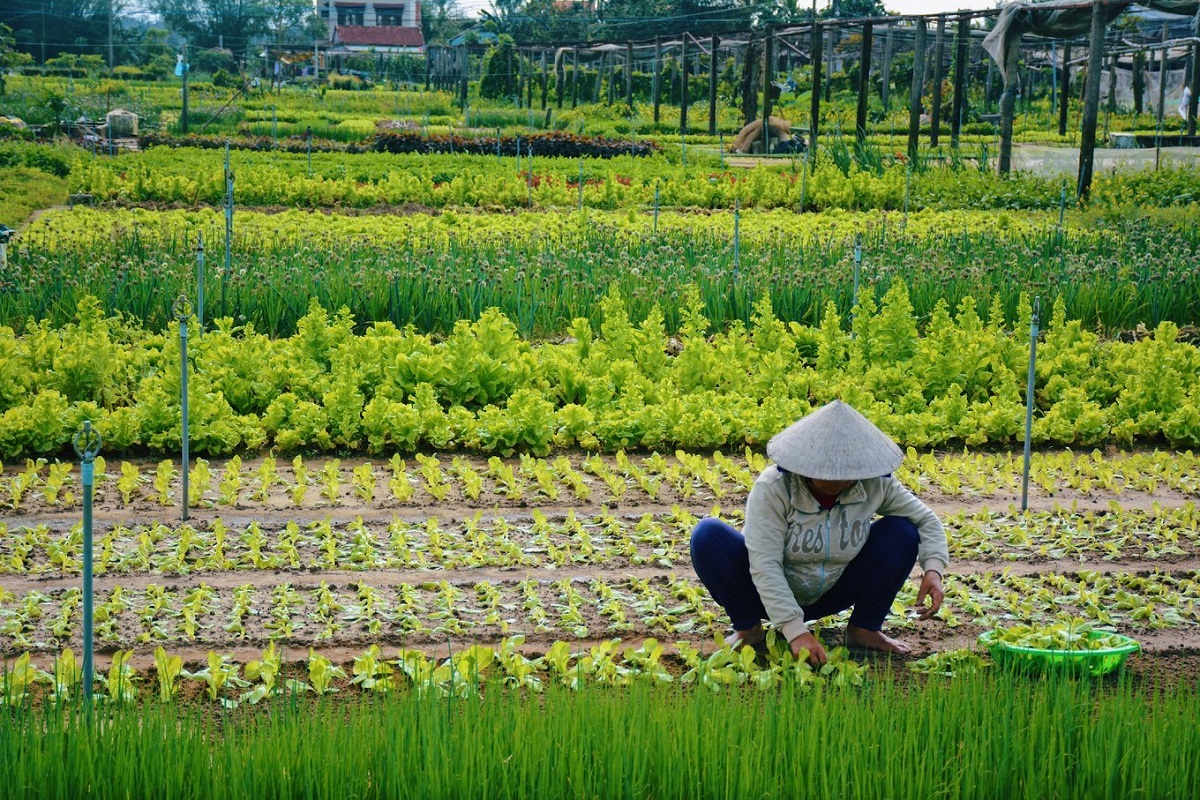
Thanh Ha Pottery Village
2 kilometers west of the Hoi An ancient town, Thanh Ha pottery village is famous for its 400-years traditional craft in making pottery. People of this village moved from another place to the present location due to a rich source of clay soil. Today, they have to buy the material from somewhere else. 30 families have preserved their ancestor handicraft, and many of them welcome visitors. This intangible cultural heritage was protected by the government at a national level, in 2019. In an artisan’s house, visitors are guided to make something by a potter’s wheel, spinned by hands or foot. Entrance fee to enter the village includes the class, costing 35,000 VND now. Read further information in Thanh Ha pottery village visitor guide.
Things to do in Thanh Ha pottery village:
– Learn to make pottery at your hands (such as a pot, tea pot, vase, etc) with an instruction from artisans.
– Visit the Thanh Ha terracotta park (an entrance ticket required)
– Sightsee historical buildings, including Nam Dieu temple or Xuan My communal house, in honour to ancestors of the villagers
– Wander around and buy unique souvenirs
– Thanh Ha fish market in the early morning.
How to get there: Hung Vuong street and then Duy Tan street lead to the village from the town centre. All road vehicles are convenient. By the river, visitors can reach it by boat (cruise) from Bach Dang quay.
Special events: On 10th day of 7th lunar month, people celebrate a festival to honour those who first made pottery in the village
Read also: Thu Bon river cruise
Book tours to Thanh Ha Pottery Village in Hoi An
Contact us by +84968009827 (WhatsApp)
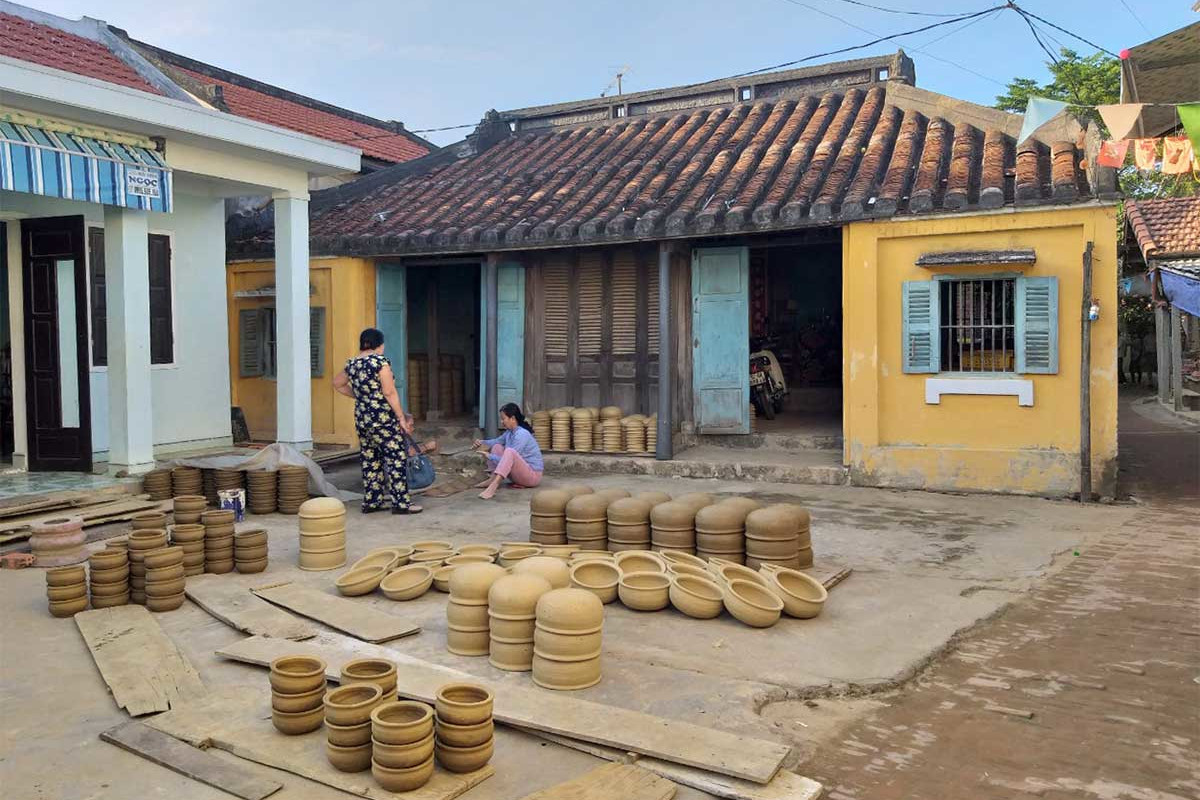
Cam Thanh Water Coconut Village
5 kilometers east of Hoi An’s old quarters, Cam Thanh’s coconut village is home of a vast, dense water palm forest. It’s a part of the Unesco world biosphere reserve designated in 2009. Historically, in the Vietnam war, this area was the hiding place of Vietcong communists. In colonial times, locals created a round boat by bamboo (like a basket) to avoid taxes from the French. Today, they use it to carry visitors around peaceful canals inside the forest and make fun-filled entertainments. Increasing visitors encourage locals to build restaurants, shops, spas and open cooking schools. Besides that, they also row the boat to catch fish and other seafood for living. Palm leaves are chopped and then sun dried for roofing and fruits of the palm are used for food preparation. Read more information in Cam Thanh coconut village traveler guide.
Things to do in Cam Thanh water coconut village:
– Discover the palm forest by a basket boat, propelled by local fishermans. See details in Hoi An basket boat ride.
– Learn to make Vietnamese foods
– Have a foot massage
– Join a class to make bamboo stuff by your hands in the Taboo Bamboo workshop. The founder and his passion are inherited from his father and grandfather.
How to get there: Visitors can choose to reach the village by one of these directions: Tran Nhan Tong road and Cua Dai – Vo Chi Cong road. All road vehicles are convenient, including bicycles and electric shuttle buses.
History: Traces of humans found in Cam Thanh’s village dated to 2,000 years ago. The first proof of Vietnamese presence in Hoi An is also seen here, a tomb built in 15th century. Many families and the palm forest accommodated Vietcong communists in the Vietnam war, more than anywhere in the area.
Read also: Hoi An cooking classes
Book tours to Cam Thanh Coconut Village in Hoi An
Contact us by +84968009827 (WhatsApp)

Cam Kim Island
Surrounded by the Thu Bon river, the largest river of the province, Cam Kim island is a peaceful and green land. It’s accessible by bridges and ferry boat from the Hoi An ancient town world heritage. In addition to Kim Bong carpentry village, this fertile island houses farmer’s villages, rice, peanut and corn fields. Thanks to being nearly-isolated (by 2015), its rural scenery and ways of life of the locals are authentic, providing a real slice of Vietnam’s countryside. Many families here have been making sedge matches or rice noodles, besides fishing. Tra Nhieu is the furthest village from Hoi An, drawing visitors by friendly people, their daily life and a non-touristy water coconut forest. Read everything you need to know in Cam Kim island traveler guide.
Read also: Cham Islands Travel Guide
Book tours to Cam Kim Island in Hoi An
Contact us by +84968009827 (WhatsApp)
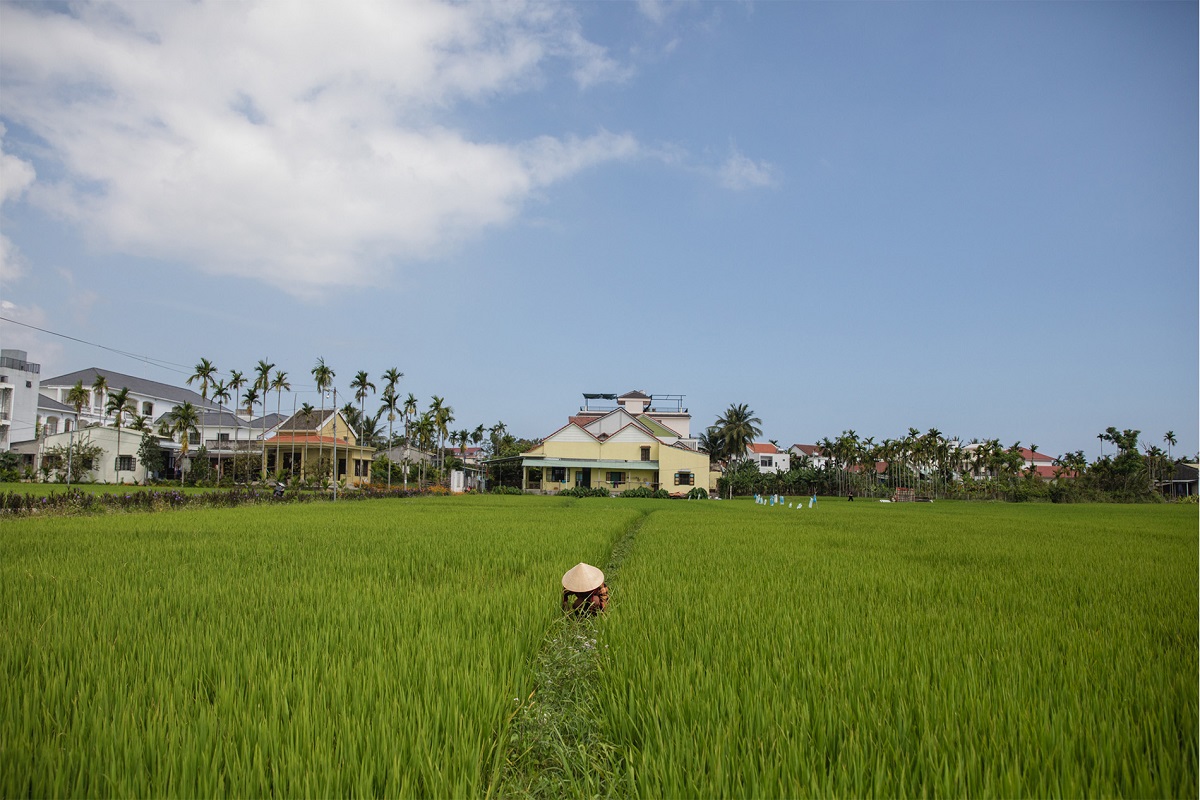
Kim Bong Carpentry Village
Located by the northern edge of Cam Kim island, in the opposite to the Hoi An old town, Kim Bong carpentry village has its own carpenter community. Since a few centuries ago, Vietnamese people here have carved sculptures by wood and built fishing boats. Today, besides producing souvenirs and household stuff, local artisans also assist in renovating wooden heritages in the world heritage town. There are two ways to get there: ferry boat from Bach Dang quay and riding across one of two Cam Kim bridges. See more details in Kim Bong carpentry village visitor guide.
Things to do in Thanh Ha pottery village:
– See real carvers and boat builders at work, and photograph
– Visit private galleries of wood works owned by famous artisans of the village
– Buy souvenirs made of wood
History: Four families from the north moved here in 15th century, including Nguyen, Huynh, Phan and Truong.
Special events: On the 6th day of the lunar new year, inhabitants of the Kim Bong carpentry village celebrate ceremonies to honour the first carpenters.
Read also: Hoi An Handicraft Workshop
Book tours to Kim Bong Carpentry Village in Hoi An
Contact us by +84968009827 (WhatsApp)
Triem Tay “Bamboo” Village
3 kilometers from Hoi An center, Triem Tay village is also known as the Bamboo village. It’s home of 140 households who live in a piece of land that is by a confluence of the Thu Bon river, opposite to Thanh Ha pottery village. While cycling around, visitors will realize that many buildings are made of bamboo here. There are homestays, restaurants, coffee shops and cooking schools. The new Cam Kim bridge was completed, allowing easy access from any banks. Riding across this village is one of the shortest ways to get from Hoi An to My Son’s Hindu sanctuary. Hidden away in lush gardens, rice fields and bamboo groves, traditional temples are for worship of the family’s ancestors and the whale. Read more information in Triem Tay village visitor guide.
Book tours to Triem Tay Coconut Village in Hoi An
Contact us by +84968009827 (WhatsApp)
Tra Nhieu Fishing Village
By the easternmost point of the Cam Kim island, Tra Nhieu fishing village (or Tra Dong village) is home of 440 families, around 2,000 people. It’s 10 kilometers away from Hoi An’s centre via the new Cam Kim bridge. Thanks to a nearly-isolated location, this village is still unknown by tourists until recent years. Most of the population here are fishermen and farmers who cultivate sweet corn, rice or peanuts. Fisherman’s culture lies on fishing nets and boats on Thu Bon river, and a temple built in the shape of a boat. In its heart, there is a water coconut forest that is better preserved than the famous one in Cam Thanh. Locals can carry visitors in a basket boat along a noise-free, palm-lined canal. Read more information in Tra Nhieu fishing village traveler guide.
Visitors can get to Tra Nhieu village by road or direct by boat on the Thu Bon river from Bach Dang harbour (the Old town). Some guided bicycle tours are organized here daily.
Book tours to Tra Nhieu Fishing Village in Hoi An
Contact us by +84968009827 (WhatsApp)
Hoi An’s Rice Fields
Rice fields are around Hoi An’s residential areas. To see them, visitors only need a couple of minutes by bicycle or motorcycle. The easiest field to get is the one Hai Ba Trung St goes across, from the Old town to An Bang beach. Not only paddies, it’s also possible to see farmers, water buffalos, white forks, wild flowers and even childrens flying the kite. Depending on different times of the year, visitors will see different stages in the growth of rice, so what they see is also unsimilar. By the traffic light of the Tra Que vegetable village, there are fish traps made of bamboo. This north section of Hoi An’s countryside is perfect to watch the sunset during sunny months, February to August. Rice fields here stretch until Cam Thanh – the eastern countryside where the water coconut forests and shrimp ponds are visible.
Southern countryside of Hoi An is on Cam Kim island. Two bridges and a ferry boat provide access to it, from the city centre and Old town. Read about Cam Kim island in the above section for further information.
Tong Van Suong street, from Ba Le market to Vo Chi Cong St, goes across green and lush rice fields of Cam Thanh. Its branch roads to the south lead to Vietnamese villages and gardens, studded with private villas and eco-friendly cottages. Some cooking schools are based here.
A small piece of rice fields is by Hung Vuong St, from the Old town to Thanh Ha pottery village.
Read also: Guide to Hoi An’s Beaches
Getting Around Hoi An’s Countryside
By Bicycle
The best way to tour around Hoi An’s countryside is by bicycle or motorcycle. Many hotels and homestays in town provide free-of-charge bicycles for the guests (come first serve first!). The bicycles there have a basket in the front, to carry bags and bottles of water, a hard seat in the back, and a bell to warn people. If not available in the hotel, visitors can walk in major streets, and it’s easy to see a place to rent a bicycle. The price ranges from 20,000 to 40,000 VND each. Helmets are not compulsory in Vietnam’s traffic law, so for safety, ask for them. In providers whose collection is of a higher quality, visitors will pay more. Contact to reliable cycling tour companies, the service is professional, with well-maintained, brand new bicycles and English speaking mechanics.
Read our article Hoi An bicycle routes to know our recommended directions to tour around the countryside of Hoi An.
By Motorbike
Like bicycles, riding a motorcycle is also flexible. However, travelers need to be a little bit more confident, carefully observe and sure, it’s harder than bicycles. All hotels don’t provide motorcycles for free but in the reception, the guests can ask for some contacts for rental. If hiring a motorbike for one day (24hrs up to different places), the pay ranges from 100,000 to 200,000 VND. It includes a helmet that is a must while driving in Vietnam and excludes gasoline. Automatic motorcycle rentals are more expensive than scooters. These kinds of motorcycles are similar to the ones in the streets. If require better quality or styles, should seek professional shops that the city has some.
Read our article Hoi An bike routes to know our recommended directions to tour around the country of Hoi An on wheels of a motorcycle.
Bicycle or Motorcycle?
Many travelers ride a bicycle to explore Hoi An’s country, but many others also enjoy touring by motorcycle. Both these wheeled vehicles allow people to access villages, laneways, roads across rice fields, and unpaved, dirty paths. Flexibility and freedom are other advantages. However, about the cost, bicycles are cheaper to hire. In many places in Hoi An, the guests can take them for free. If hire one, the price is not really a big deal (just 1-2 dollars!). Not only traveling, bicycle riders will do exercise too, and it’s good for physical and mental health. Adrenaline seekers may not miss a bicycle tour in their time at Hoi An. Keep in mind to check the weather forecast in advance and ensure that the day you go is sunny or at least dry.
The entire drive is shorter if travelers ride a motorcycle instead of a bicycle. For those who have physical problems, a motorbike balances “adventure” and “fitness”. By that, they can stop at more places and stay longer there. In guided motorbike tours, travelers have a pillion ride (sitting in the back!). So, they can take so many pictures, videos and expect a safer trip.
Countryside Tours in Hoi An
Visitors have many guided tour options to discover peaceful, charming countryside of Hoi An. Much of them are run on a half-day basis, morning or afternoon. One of the reasons is to avoid the heat of midday. Bicycles are the most selected vehicle because riding them allows to approach villages, see rural sceneries and the life of locals, at a slower pace. In a bicycle tour, local guides will recommend quiet backroads or scenic routes, instead of busy ones. The riders definitely have a great time while riding across villages, rice fields, gardens, forests and along rivers. It’s better for traffic safety too. In order to know better the daily life and work of locals, some families are visited, to interact and have hands-on experiences. Highly recommended to adrenaline seekers!
Traveling by motorcycle is another popular way. Motorcycles allow travelers to reach further, but still retain the flexibility and freedom of the bicycles. Mostly, a local licensed driver is organized, to carry a foreign traveler behind. For people who don’t have good fitness, this is a suitable option, for exploration and health.
Read also: – Typical Hoi An countryside tour (3 villages)
– Cam Kim island tour
Self-Guided Cycling Tours in Hoi An
With a bicycle and our Hoi An’s cycling routes map, travelers can discover the countryside of Hoi An by themselves. They customize the itinerary: time to start, length of the ride and the places they want to see. By that, the trip can be extended, longer or shorter than a half-day, and is fitted to personal requirements and likings. Many experiences (even in the countryside) that tourists need to pay or donate, so sometimes, it’s cheaper if traveling by yourself.
However, if traveling by yourself, it takes a longer time to design the best route that avoids the hustles and bustles. Following a local guide, you can experience a moderate drive through quaint villages, laneways, rice fields, gardens, and especially, see local families there. There, you can learn about their own life stories, and join their daily works that help them to earn for living. Thus, without a local, it’s really not easy to look for and interact with (rustics don’t know English!). The guide, he or she also assists in different situations, for example, the bicycle breaks down suddenly. Some of them are mechanics.
Read also: Hoi An Self Guided Walking Tour
Hoi An Countryside Map
Related Posts
Non Nuoc Beach: The Famous Beach of Da Nang
Besides the Golden hands bridge – a global hit, Da Nang city also has beautiful beaches. If looking for somewhere great to stay and have a slow holiday, Non Nuoc
How to Get from Da Nang to My Son Sanctuary
Known as ‘the Angkor Wat of Vietnam’, My Son sanctuary boasts of its sophisticated temples dating back from 4th century. Sadly, in 14th century, it’s abandoned in the forests. Today,
Thieu Tri Tomb: The Peaceful Royal Tomb of Hue
Thieu Tri emperor tomb is an unpopular place to visit in Hue. From the city centre, it’s closer than Khai Dinh tomb, Minh Mang tomb and Gia Long tomb, and
Bach Ma National Park: Hiking, Trekking in Da Nang and Hoi An
Two best places for trekking and hiking in and near Da Nang are Son Tra mountain (peninsula) and Bach Ma national park. Which one is better is actually personal because these
Hoi An Wet Season: What to Do in Hoi An When It Rains?
No beach, no pool, no outdoor adventures? What to do in Hoi An when it rains? This is a very popular question from travelers who come to Vietnam in the
Hue to Da Nang By Train: The Best Train Ride in Vietnam
Like Hanoi to Sapa, many travelers choose to get from Hue to Da Nang by train. Not just a cheap deal, the experience on this ride is definitely stunning and
Hue Royal Tombs: A Complete Guide and What is Best?
The Nguyen dynasty existed 143 years, from 1802 to 1945 with 13 emperors, but only 7 of them had their own mausoleum. On the map, all of these buildings are
The Hue Abandoned Water Park (Thuy Tien Lake Waterpark)
Recently, the Abandoned water park in Hue is known by travelers worldwide thanks to social media and online magazines, just like the Golden hands bridge in Da Nang. It was
Minh Mang Tomb Complete Visitor Guide
Minh Mang is the 2nd ruler of the Nguyen dynasty, the king of Vietnam from 1820 to 1840. His contributions to the country can’t be counted, including the largest territory Vietnamese
Tu Duc Tomb Complete Visitor Guide
Tomb of Tu Duc emperor is one of three most visited royal mausoleums in Hue. Two others are Minh Mang tomb – the tomb of Tu Duc king’s grandfather and
Thanh Ha Terracotta Park
Between 15th and 19th centuries, Hoi An was one of major stopovers for sailing merchants to trade in Southeast Asia. Meanwhile, craftspeople in its Thanh Ha village produce high-quality pottery
Vinwonders Nam Hoi An Theme Park (formerly Vinpearl Nam Hoi An)
In addition to historical and cultural attractions, nowadays Hoi An also has a couple of amusement parks to entertain. Definitely, they’re ideal places for families with children and groups of
Am Phu Cave (Hell Cave) – Things to Do in Da Nang
Although in the Marble mountains – the most visited attraction in Da Nang, travelers often miss Am Phu cave. One of reasons is that it’s mentioned much online and not
Hoi An or Hue: Which is Better?
Both Hoi An and Hue cities are in the middle of Vietnam, and they’re not far from each other (about 130 km). Therefore, for those who travel from north to
Asia Park and Sun Wheel in Da Nang (Sun World Da Nang Wonders)
Have you ever seen the wheel of Da Nang? That is the Sun Wheel. It’s a part of greater Asia Park – an amusement park with a heap of fun
The Official Hoi An Travel Guide (MUST READ)
By the estuary of Thu Bon river, Hoi An is one of the best places to visit in Vietnam. This Vietnamese town is a package for travelers – a pretty
The Hoi An Market (Hoi An Central Market) Complete Guide
The Hoi An Market is the first market in Hoi An ever. Over centuries, it’s still the largest market in town although the town has a much bigger size than
Hoi An Memories Show: The Best of Hoi An Impression Theme Park
The Hoi An Memories Show is a famous series of outdoor performances in Hoi An at the present time. Thanks to its exceptional production and great cultural stories, it becomes
How to Get to Golden Bridge from Da Nang
The Golden Bridge (aka the Golden Hands Bridge) in Da Nang is a must visit attraction in Vietnam today. Many foreign travelers come to the city, just because they love
Hoi An Bridge: Famous Bridges in Hoi An
Hoi An has many bridges because it’s located at the confluence of 3 rivers: Thu Bon river, De Vong river and Truong Giang “Long river”. The distributaries of these rivers
Da Nang Food Specialties: What to Eat in Da Nang
Da Nang is known as a food capital of central Vietnam. This city boasts many yummy dishes, prepared by distinctive recipes and some of them are famous all over the
How to Get From Hoi An to My Son Sanctuary
My Son sanctuary is one of the most popular places to visit for tourists staying overnight in Hoi An, especially those who spend many days there. It’s known for a
Hoi An’s Chinese Assembly Halls and Chinese Temples
Chinese people migrated to Hoi An from the early 17th century. Today, Chinese communities as a whole are the second most important piece to form the town’s unique culture. The foremost
Hoi An Walking Tours: Heritage, Foods, Photography & Locals
Strolling around heritage quarters with a local guide is the activity that so many travelers love to do in Hoi An. It enriches their time in this lovely town. Firstly,
Hoi An Self Guided Walking Tour – Hoi An On Your Own
Hoi An old town is friendly for pedestrians, especially during the time that motorized vehicles (scooters, cars, etc) are prohibited to move around its heritage quarters. That is safe for
How to Visit Golden Bridge Vietnam
The Golden Hand Bridge of Ba Na hills today is a dream place to visit for many travelers. Since it opened in June 2018, millions of people have set their
Da Nang Shore Excursions: Guided Tours From Tien Sa Port
Da Nang Vietnam today is one of stopovers for many cruises that travel from continent to continent, from country to country. It owns an ideal seaport to moor and it
Unique Experiences in Hoi An and Why?
Today, travelers seek more experiences in the destination they go to. They want to have a deeper understanding about the culture of local people and interact with them. No other
Han Market (Cho Han): Where to Shop in Da Nang?
In the heart of Da Nang, the Han market is a popular place for visitors to buy something to bring home due to the diversity of merchandise. Back to history,
An Bang Beach: A Guide to Hoi An’s Best Beach
An Bang beach now becomes a popular tourist attraction in Hoi An. It may be the best known and most convenient to reach from the town’s centre. Not only tourists,
Experiences in Hoi An: Get Insight Into Hoi An’s Local Culture
As the most unique Vietnamese town, Hoi An is definitely worth visiting. Here, visitors have many things to do and experiences for their holiday time. Everyone knows that it has
Da Nang Cathedral (Da Nang Pink Church)
Da Nang became a French protectorate on 3rd October 1888, under the name “Tourane”. By the Han river, the colonists designed a grid of streets with public buildings, a city hall,
Things to Do in Ba Na Hills Besides Golden Bridge
According to local authorities, 50% of visitors coming to Da Nang and Hoi An visit the Ba Na hills. In other words, that is nearly 10 millions of people. This
Hoi An Nightlife: What to Do in Hoi An At Night?
After dark, Hoi An becomes exceptionally spectacular. If planning to stay overnight or visiting this ancient heritage town, at least travelers know that it’s “decorated” by so many colorful lanterns.
Hoi An Countryside: Villages, Rice Fields & Tours
By the coast, Hoi An is at the confluence of 3 rivers: Thu Bon river, Truong Giang river and De Vong river. This economically strategic location has supported trading activities
How to Get to Golden Bridge From Hoi An
There are many travelers visiting the Golden bridge from Hoi An. Both the bridge and the town today are must-see places in the region, so staying overnight in the town
Hoi An Entrance Fee: Old Town, Golden Bridge, My Son, More
Are you planning to visit Hoi An? And you don’t know how much cash you need to prepare for visiting places? This article lists tourist attractions in Hoi An and
Hoi An Airport: Everything You Need to Know
Hoi An is a famous tourist city in Vietnam. It’s 800 kilometers away from Hanoi, the capital of Vietnam and nearly 1,000 kilometers from Ho Chi Minh city, the biggest
Hoi An Lantern Boat Ride on Hoai River
A lantern boat ride is a thing to do that visitors must do today in Hoi An. For many centuries, locals have taken it on the Hoai river by the
Da Nang Half Day Tours
In addition to day trips, travelers have many options of half-day tours in Da Nang to choose from. Not to spend a full day at different places, maybe far from
Hoi An Private Car and Driver
Hoi An is one of the most popular tourist destinations in Vietnam. In the busiest year, it attracts about 9 millions visitors who come to enjoy its charming beauty, rich
Da Nang Private Car and Driver
Your next holiday destination is Da Nang? You prefer to travel by yourself? Hiring a private car is one of the best options for you to explore with freedom, flexibility
What to Do in Hoi An Ancient Town
Hoi An Ancient Town is a must see, not only thanks to its world heritage title, but also to its vintage urban landscape, lots of attractions and activities. In the
Da Nang and Hoi An Itinerary for Visitors Staying Overnight in Hoi An
Da Nang and Hoi An are twin cities in the heart of Central Vietnam. Both are popular tourist destinations for either domestic or international visitors, and share many similarities. Due
Hoi An 3 Day Itinerary: A Travel Plan for 3 Days in Hoi An
3 days are a perfect duration to stay overnight in Hoi An and explore captivating places in and around it. Especially for those who travel from city to city or
Hoi An Free Things to Do: Budget Travel in Hoi An Vietnam
Travelers should know free things to do in Hoi An, to save the budget for this wonderful city and by that, can stay longer to explore. From old town, countryside
Hoi An One Day Itinerary: A Travel Plan for One Day in Hoi An
From a backwater town in the 1990s, Hoi An today is one of leading tourist destinations across Vietnam. In a recent year, it attracted 8,5 millions of overnight visitors and
Da Nang Things to Do: Guide to What to Do in Da Nang Vietnam
Unquestionably, Da Nang deserves a holiday trip from all types of traveller. Firstly, due to the weather. It has a longer sunny time than the north but less hot than
Da Nang Best Things to Do and Reasons
Da Nang is the largest tourist center in Central Vietnam. It owns fascinating natural and cultural places that attract both Vietnamese and foreigners. In the busiest year, this city of
Hoi An Half-Day Tours: Guide to Half Day Trips From Hoi An
Top attractions near Hoi An require a couple of hours or half a day, to get there and visit around. The reason is that all have many things to see,
Hoi An Day Tours: A Guide to Best Day Trips From Hoi An
Near Hoi An, there are many fantastic places making travelers can’t stay in the room and have to go out to explore. Appeal Golden bridge – the new world wonder,
Hoi An Beach: A Guide to All Beaches in Hoi An Vietnam
Not only an old town, Hoi An has beaches as well! That are sandy, edged by tropical water and lined by palm forests. Travelers don’t need to wait or move
Hoi An Food Specialties
Hoi An is a melting pot where people from different parts of Vietnam and countries in the world have gathered and exchanged their cultures. As a result, this town has
How to Get From Hoi An to Da Nang
Da Nang is the neighbouring city of Hoi An. It's the capital of Central Vietnam and has the most important (busiest) transport hubs of the region, such as airport, train
Hoi An Cheap Things to Do: All Solo Travelers Need to Know
Knowing free and cheap things to do in the city where travelers are going to visit, is helpful. First of all, they can save and, thanks to that, can stretch
Hoi An Best Things To Do: Recommendations from Local Experts
It is no coincidence that Hoi An is in the list of must-visit places once in the lifetime of many travelers. Located by a river, it’s borned to welcome people
Hoi An Things to Do: All What Can You Do in Hoi An Vietnam
Hoi An is in the bucket list of most travellers who plan to visit the Central part of Vietnam. It’s a lovely old and small town located downstream of a
Hoi An Things Not to Miss: A Guide to Must Do in Hoi An
In fact, there are so many things to do in Hoi An, one of the 10 best cities in Asia by Travel + Leisure in 2021. It has a lantern-filled
Hoi An or Da Nang: Which is Better for First Time Visitor?
Da Nang and Hoi An are located in Central Vietnam, with a distance of roughly 30 km. To the north, Da Nang is the capital city of the region, with
Hoi An Pottery Village: A Guide to Thanh Ha Pottery Village
Hoi An used to be a bustling, prosperous trade port during past centuries, before its role was replaced by Da Nang. Merchants from many countries on different continents came here
Hoi An Ancient Town Tour
Hoi An Ancient Town is a Unesco world heritage site by the mouth of the Thu Bon River. It has grid-plan streets filled by silk lanterns and bougainvillea flowers that
Hoi An Old Town Ticket: Price, Sellers, Included Sites, More
As an attraction including attractions, Hoi An Old Town requires an entrance ticket to tourists who come from other parts of Vietnam and the world. It raises funds for preservation of
My Son Sanctuary Tour
My Son Sanctuary is a Unesco world heritage site, attracting 450,000 visitors in recent years. It’s the best remains left by the fallen Champa Kingdom which ruled a part of
Hoi An Lanterns: Festival, Making Class, Where to Buy, More
Lanterns are the signature of Hoi An Old Town, the 3rd Unesco world heritage site in Vietnam. Especially at night, these traditional handicraft objects are lit up and make the town
Hoi An Best Area to Stay: Guide to Where to Stay in Hoi An
In the busiest year, nearly 5,5 millions travellers decided to stay overnight in Hoi An. It’s the largest number that a city in the Central coast of Vietnam ever achieved.
Hoi An Weather by Month: Guide to Hoi An Monthly Weather
Hoi An won the title “Asia’s leading cultural destination” recently in a reputable global travel award. It’s a pretty riverine-coastal town with an ancient root, surrounded by peaceful pieces of
Da Nang Best Area to Stay: Guide to Where to Stay in Da Nang
In the Central coast, Da Nang has an area of 1,285 km2 and population of 1,134 people, making it become Vietnam’s 4th largest city. It plays an important role in the
Da Nang Cave Tour: Best Underground Activities in Da Nang
Different from Hue and Hoi An, Da Nang has limestone caves and grottoes. All of them are within the Marble Mountains (Ngu Hanh Son), a complex of 5 amazing hills
Da Nang Best Time to Visit: Guide to Best Weather in Da Nang
Da Nang is titled “Asia’s leading festival and event destination” by the World Travel Awards or Vietnam’s greenest city by the WWF. Its reputation comes from amazing natural mountain-to-sea sceneries,
Da Nang Weather by Month: Guide to Monthly Weather in Da Nang
In Central Vietnam, Da Nang has a tropical monsoon climate with two distinct seasons that each starts later than the North 2 months. Because of being shielded by the spectacular
What to Do in Da Nang At Night
Between the sunset and midnight, there are many things to do in Da Nang that travelers should know before getting to bed. Thankfully, different styles of traveling, budget or ages
Lang Co Vietnam Travel Guide
Lang Co was a lovely backwater town nestled at the foot of spectacular Hai Van Pass for some decades. Not yet widely known because of the popularity of beaches in
Hoi An River Cruise: Guide to The Best Boat Tour in Hoi An
Hoi An town is by the left bank of the Thu Bon River, and by that, it draws plenty of merchants by sailing boat to visit and trade. Its golden
What to Do in Da Nang for 3 Days
Da Nang is a lovely coastal city in the middle of 3 Unesco world heritages Hue, Hoi An and My Son Sanctuary. This most worth-living municipality owns a poetic river
Hoi An Old Town Boats: Guide to Boat Rides in Hoi An Town
Hoi An town sits by the left bank of the Thu Bon River, the largest and most important waterway in mother Quang Nam province. It’s also near the mouth of
Hoi An 2 Day Itinerary: Traveler Guide to 2 Days in Hoi An
2 days are enough to know the highlights in Hoi An, a famous tourist destination in Central Vietnam. And for those who travel from city to city, 48 hours are
Cham Island Hoi An
The purple islands seen from An Bang or Cua Dai beaches are the Cham Islands. It’s one of the kind in the region where God bless it with fabulous beautiful
Hoi An Basket Boat Ride
Nowhere else outside of Hoi An Coconut Village, travelers can find a basket boat ride across the immense palm forests. It’s an experience that allows the passengers to know better
Hoi An Coconut Village: A Guide to Cam Thanh Coconut Village
Hoi An Coconut Village boasts of the most interlaced waterway system in the city. Four rivers encircle it and are connected together with smaller canals. Thanks to fertile alluvia and
My Khe Beach: A Complete Guide to Da Nang’s Best Beach
Da Nang is a lovely seaside city with many beaches, and the best is My Khe. Located on the eastern coastline, it’s between little-known beaches near the foot of Son
Thien Mu Pagoda: Guide to Hue’s Most Famous Buddhist Temple
Thien Mu Pagoda is in the itinerary of any Hue city tours and day trips from Da Nang or Hoi An, because of its various interests. In short, it’s really
Perfume River Cruise: Guide to Best Boat Tour in Hue Vietnam
Perfume River cruise is a popular activity in Hue, Vietnam. Different from other sightseeing rides, this experience is by a dragon boat that was used only for the king formerly.
Tomb of Khai Dinh: The Most Unique Royal Tomb of Hue
Tomb of Khai Dinh is the last emperor mausoleum built in Hue and Vietnam. It’s famous for one-of-the-kind architecture and art that was never seen in the country at that
Da Nang Day Trips: Guide to Best Day Tours From Da Nang
Centre and outskirts of Da Nang have incredible attractions where travellers need to spend many hours to get to and fully explore. There are the Ba Na Hills and Golden
Museums in Da Nang
Da Nang has many museums where visitors can see and learn a lot. Generally, their exhibitions have different themes, varying in stages of the history, groups of people (communities) having
Linh Ung Pagoda: Trio of Da Nang’s Holiest Mountain Temples
Linh Ung means “wishes answered miraculously” in Sino-Vietnamese. And it’s first used in 1841 to name a pagoda in the Marble Mountains by Thanh Thai, the 10th king of the
Da Nang Night Market: A Thing To Do in Da Nang at Night
Different from day markets in Da Nang, night markets are held open-air and on streets where traffic is active during sunny hours. A visit there provides the chance to understand
Guide to Son Tra Mountain (Monkey Mountain) in Da Nang, Vietnam
From My Khe Beach or Han River promenades, tourists can see a part of the Son Tra Mountain. Although being near the city center, natural forests on its slopes have
Ba Na Hills Tour
Ba Na Hills is one of the best attractions in Da Nang, and the country. Its full name is the Ba Na-Suoi Mo Tourist Area, made from “Ba Na hill
Hoi An Cham Temples: My Son Sanctuary & Quang Nam Temples
Cham people settled in Hoi An before the Vietnamese arrived and handed it over in 14th century. Influenced by Indian culture, they called the land “Amaravati”, similar name to a
Da Nang Cable Car
No surprise that now, when travelers make the plan to tour around Vietnam, there are many cable car rides recommended. Some are top things to do in its cities. The
How to Get from Da Nang Airport to Hoi An
Located in the city of the same name, Da Nang airport is the nearest airport to Hoi An. So, if travelers want to see an extremely-colorful Lantern festival or try
Da Nang to Hoi An: Best Da Nang Airport Transfer and More
If traveling to Hoi An by air, train and cruise ship, visitors will come to Da Nang first and then have a transfer. The largest city of Central Vietnam holds
Hoi An Tour Guide: How to Find a Private Tour Guide in Hoi An
Most tour packages in Hoi An cover “ a guide”. He or she may be the first and closest local to the visitors, who lead the group to enjoy the
Hoi An Ancient Town Attractions
Spreading over an area of 30 hectares, Hoi An Old Town owns more than 1,100 timber buildings varying in function or type. In the oldest street, the Japanese bridge spans
Hai Van Pass Da Nang: Map, Route, Weather, History, Tour
Truong Son or Annamite Range is the most dramatic mountain ridge in Vietnam. When it juts out into the sea, spectacular Hai Van Pass is formed. This amazing sculpture of
Hoi An Old Town Map
There are so many things to see, do, eat and sleep in Hoi An Old Town, so the visitors often are confused while planning and exploring. Starting the research from
Tra Que Vegetable Village
Located in a prime location between two famous attractions, the Old Town and An Bang beach, Tra Que vegetable village is a featured point of interest. It’s famous for vegetable
Guide to Hoi An Lantern Festival – Hoi An Full Moon Festival
The Lantern Festival is amongst the best times to visit Hoi An. In which, visitors will immerse themselves in a shimmering world of uncounted lantern lights. When the crowds fill
Hue Imperial City and Forbidden City
Located by the Perfume River, Hue Imperial City and Forbidden City are the 2nd and 3rd walls of the Citadel, seat of Vietnamese power from 1802 to 1945. These are home of luxury-decorated palaces,
